It seems we can’t find what you’re looking for. Perhaps searching can help.




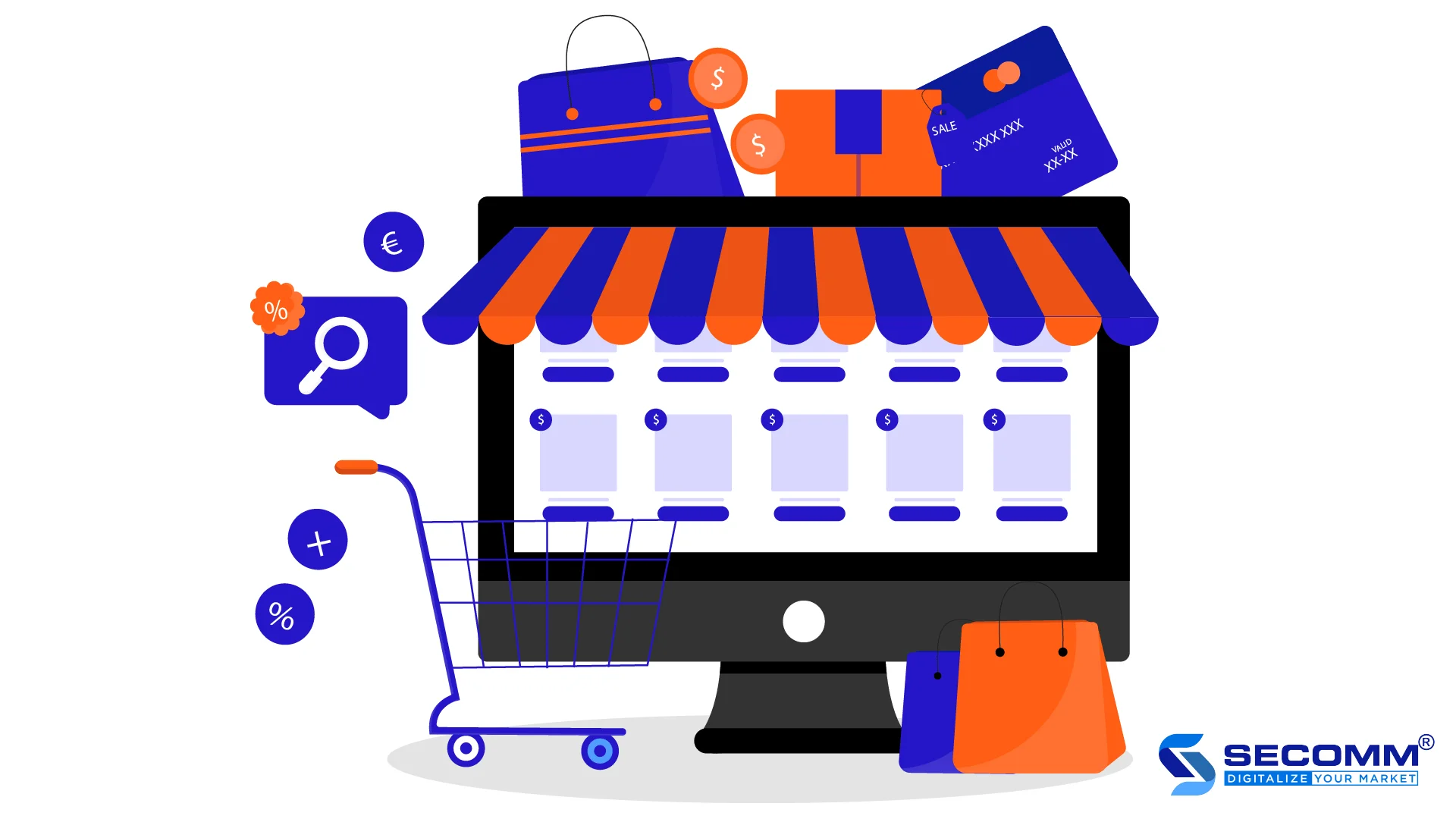
6 STEPS TO BUILD A PROFESSIONAL ECOMMERCE WEBSITE
Trends in consumer shopping are shifting from offline to online, especially among the younger generation—an important factor impacting the new economy. Building an ecommerce website is crucial for the success of ecommerce businesses in today’s digital economy. So, what should businesses do to build a professional ecommerce website?
Define the goals of the ecommerce website
Objectives:
Businesses need to determine the purpose of the website and the priority of each goal to plan the development of the website according to each stage:
- Increase revenue: Add a sales channel to boost sales activities.
- Brand positioning: Build a brand to establish a strong presence in the ecommerce market.
- Marketing support for the business: Use tools like Google Analytics and Facebook Pixel to analyse customer behaviour, build a suitable Ecommerce Marketing strategy, reach more potential customers, and increase conversion.
- Enhance user experience and interaction: Support payment services and backend services to increase interaction, support, and provide customer advice more efficiently.
Requirements:
The ecommerce website needs to have a powerful configuration, a professional interface, and a diverse system of functions to meet the growing needs of customers. When designing the website, businesses should pay attention to:
- Website performance needs to ensure page load speed, large storage capacity, and compatibility with all devices.
- The interface is considered the face of the brand when customers visit the website. To create a good impression and keep them engaged, the interface must meet basic criteria:
- Professional and brand-image-conveying interface.
- Scientifically designed structure, compatible with customer behaviour.
Example: The structure of some common pages of an effective e-commerce website:
- Home page: Program banners and product or service categories.
- Product category page: General description of the category and products in the category.
- Product detail page: Description of product attributes, images/videos, prices, promotions, inventory information, customer reviews, and suggestions for similar products.
- Account registration page: Request basic information (Name, Email, Phone, Gender).
- Account management page: Personal information, password changes, order status.
- Shopping cart page: Avatar, product name, quantity, price, discount code.
- Checkout page: Order information, payment, shipping, invoice generation.
- Contact page: Hotline, email, business branches, contact form.
To maximize the customer experience, the ecommerce website needs to integrate features that support personalized customer experiences, aligning with their shopping behavior.
Example: Some common features:
- Product category management: Unlimited product quantity, multi-level category navigation, custom filters, and extensions supporting SEO indexing.
- Sales management: Order control, payment, shipping, staff responsible for handling.
- Customer management: Update customer information, register/log in through social media accounts such as Facebook/Google.
- Marketing management: Set up supporting tools like Google Analytics, Google Tag Manager, Google AdWords.
- Content management: Integrate SEO tools, customize menu layouts, CMS content.
- Inventory management: Use management tools to process orders, inventory management, and distribution systems.
- Reporting and Analysis: Analyze sales activities to assess customer insights, forecast business results, and propose business strategies.
Determine the time and budget for implementation
Depending on the goals and complexity of the e-commerce website, determine the time and budget. To accurately determine the time and budget, businesses should seek advice from experienced and professional units.
Choose an ecommerce website development platform
Each platform has its advantages and disadvantages. Businesses need to consider choosing a website development platform that is suitable for their e-commerce business strategy. Some popular platforms include:
- Pros: Open-source platform specialized for e-commerce, versatile, highly customizable.
- Cons: High development costs, requires expertise and experience during implementation.
Suitable for businesses investing in the long term, saving budgets in the long run.
- Pros: Easy to use, many ready-made interfaces and widgets, 24/7 support.
- Cons: High costs (ongoing high cost), unstable website speed.
Suitable for building simple and less customized e-commerce websites.
- Pros: Simple, easy to use for businesses, many templates.
- Cons: Limited features, poor security, suitable for building e-commerce websites for new brands entering the e-commerce market with limited budgets.
- Pros: Supports payment features and integrates various marketing tools.
- Cons: Limited annual revenue. Standard package: $29.95/month, revenue limit: $50,000/year.
Suitable for building e-commerce websites for new businesses with relatively low revenue.
- Pros: Simple, easy to use, many templates.
- Cons: Cannot be edited for a unique style, suitable for building e-commerce websites for new businesses and small-scale enterprises.
Choose an ecommerce website design unit
When building an e-commerce website, businesses need to collaborate with units based on certain criteria:
- Deep experience in e-commerce: Number of years of experience, quantity, and quality (type of projects, complexity, etc.) of completed projects.
- Professional team: Solution consulting staff, IT staff, customer service staff.
- Clear process from business analysis, proposed solutions, development, testing, and maintenance.
- Available system.
- Efficient handling and support.
- Commitment to warranty and maintenance.
- Upgrade and maintenance services for the e-commerce website.
Some ecommerce website design units in Vietnam include:
- Magento: Secomm, SmartOSC, MoniGroup, Co-well Asia, etc.
- Shopify: Webico, Meowcart, Duyalex, etc.
- BigCommerce: Itexpress, Websolution, etc.
Purchase domain name and hosting
Criteria for choosing a domain name: Short, easy to remember.
Criteria for choosing hosting providers:
- Examine the configuration: Disk Space, Bandwidth, Parked Domain, CPU, RAM, FTP accounts, MySQL accounts, dedicated IP, etc.
- Support services: Data backup, 24/7 live chat support, submitting a ticket to resolve issues.
Develop the ecommerce website
Coordinate with the development unit to ensure a smooth development process. Businesses should regularly update the project progress according to the approved solution. Simultaneously, update changes and coordinate with the cooperating unit. During the User Acceptance Test (UAT), businesses should test according to a checklist to ensure that the website development process meets expectations.
During the development process, businesses also need to work with payment and shipping units to provide services for the ecommerce website. When signing contracts with payment units, attention should be paid to security, compatibility between the website platform and the payment platform, and service fees. Some common online payment gateways in Vietnam include Paypal, Ngan Luong, VNPay, Airpay, and e-wallets such as Momo, ZaloPay. When cooperating with shipping units, businesses should consider the quality of services, shipping staff, packaging, and storage of goods to avoid affecting the user experience
 2
2

 27,833
27,833

 0
0

 1
1
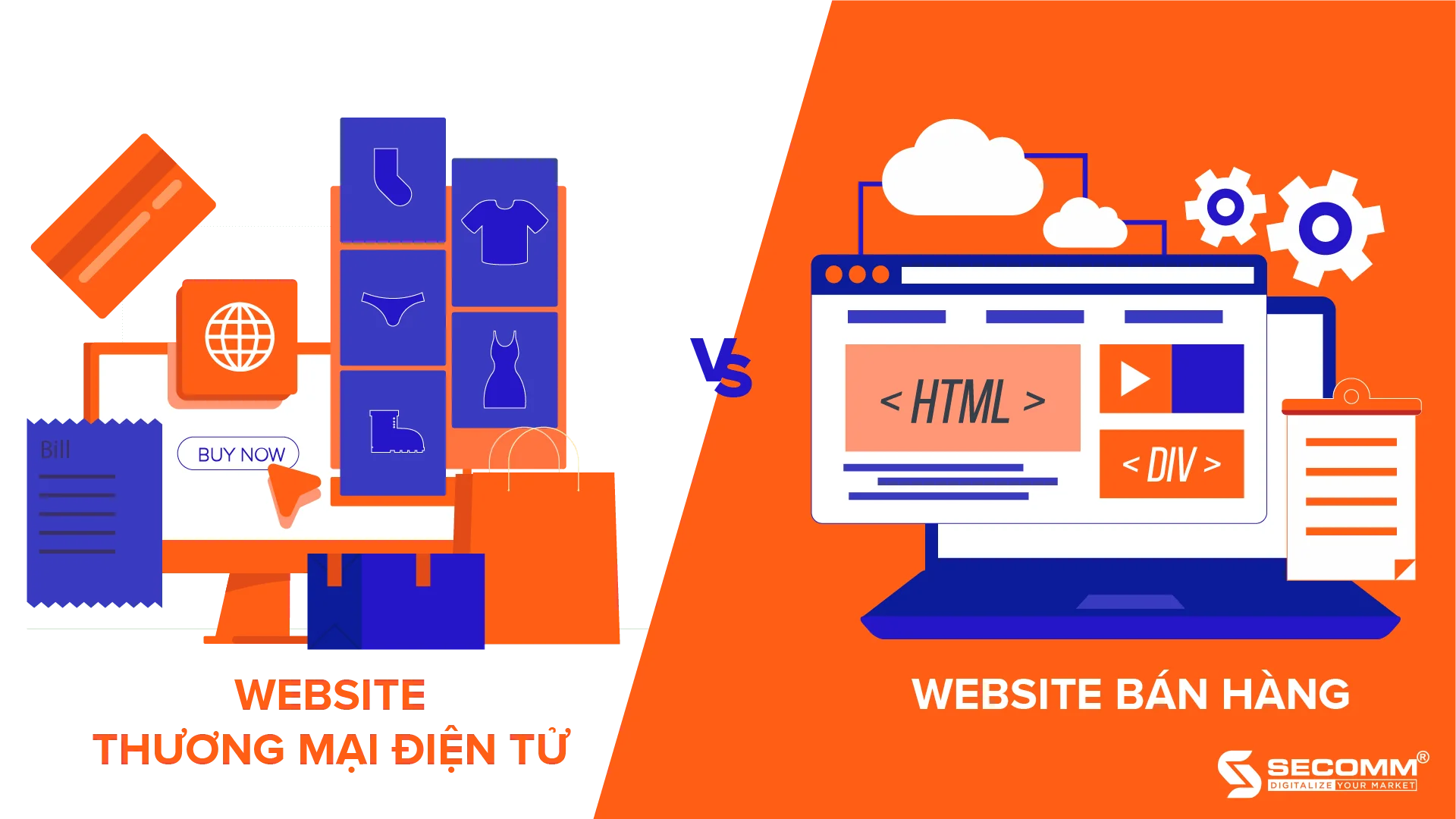
DIFFERNTIATING ECOMMERCE WEBSITES AND SHOPPING WEBSITES
Ecommerce websites and online shopping websites both serve the purpose of buying and selling products and services online for businesses.
So:
- How are e-commerce websites and online shopping websites different?
- When should an e-commerce website be built?
- When should a shopping website be built?
Website Purpose
An e-commerce website is established to serve the entire process of selling goods or providing services, from providing information and introducing the business, products or services, to supporting payment and post-purchase services. In particular, the payment feature on e-commerce websites is executed through multiple steps and follows certain standards. On the other hand, shopping websites mainly provide information about the store, business, or the products and services offered.

Website Scale
In terms of scale, e-commerce websites typically have a diverse range of product categories and services. In contrast, shopping websites usually only deal with a specific set of products or areas, so the scale is generally small to medium.
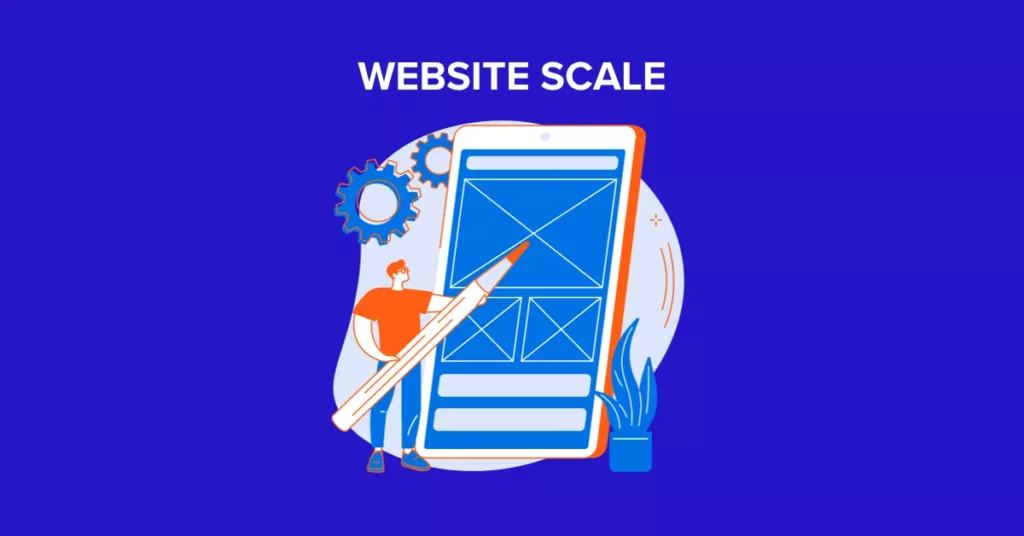
Website Features
To present a variety of products, and services to customers, and support businesses in managing their online business systems, e-commerce websites need a complex back-end operating system (data access layer) with integrated functions such as customer management, product category management, analysis and reporting, SEO support, Ecommerce Marketing, Omni-channel (ecommerce platforms such as Shopee, Lazada, Tiki, Sendo; social networks such as Facebook, Zalo, Tiktok, Linkedin, and individual e-commerce websites…) online payment, and shipping services. In contrast to e-commerce websites, shopping websites primarily introduce businesses and products, so they do not require the integration of many supporting features.

Website Interface
The interface of ecommerce websites is usually focused on and designed meticulously with a standardized UI, UX. Not only eye-catching, professional, and impressive, the interface of ecommerce websites also needs to demonstrate the complex features underlying the system and provide an optimal online shopping experience for users. Shopping websites have a simple interface and operational functions because they focus on only one type of product or specific area.
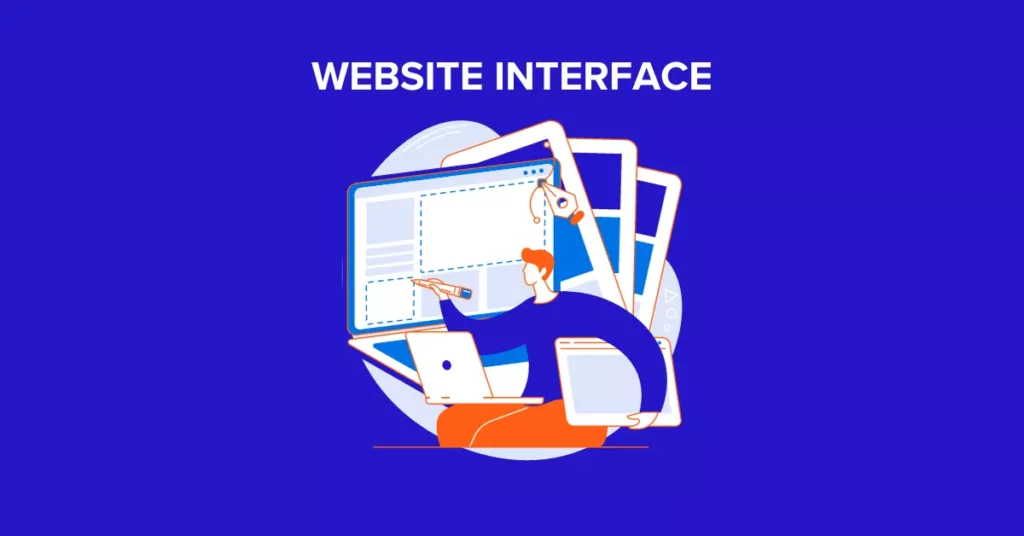
Website Investment Costs
With a professional interface and a complex feature system, the investment cost for designing e-commerce websites is generally higher than for shopping websites. Especially for websites with a diverse feature set, the costs can be even higher. Regarding shopping websites, the development cost is usually lower as they are developed from a simple platform and sometimes do not require much specialized knowledge.
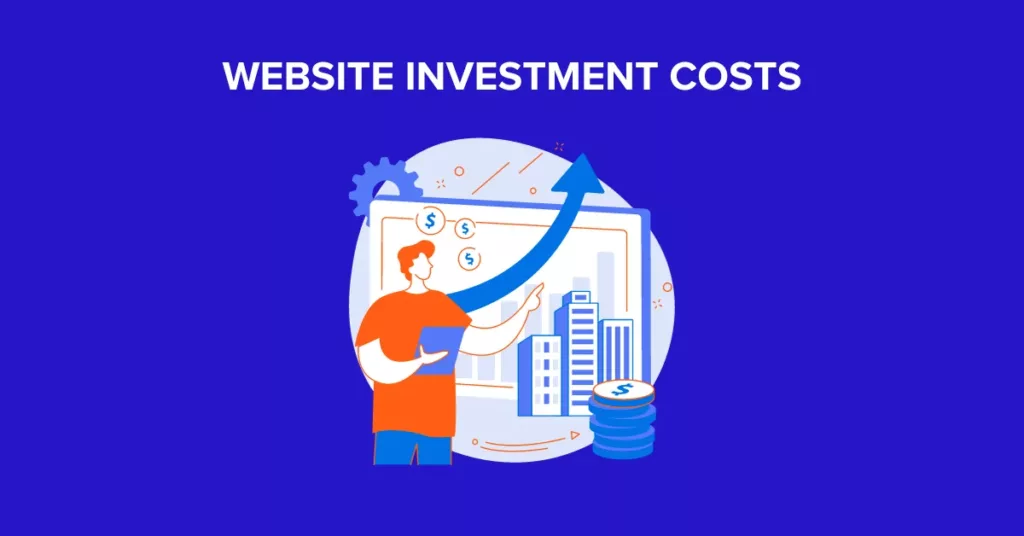
In summary, shopping websites are suitable for businesses that deal with a few products, services, or a specific industry group, do not require many complex features, and need to save website construction costs.
On the other hand, e-commerce websites are suitable for businesses with a diverse range of products and services, have the need to develop an ecommerce system for long-term business and budget savings, have specific growth goals, and have the financial capacity to enter the ecommerce market.
 2
2

 2,917
2,917

 0
0

 1
1
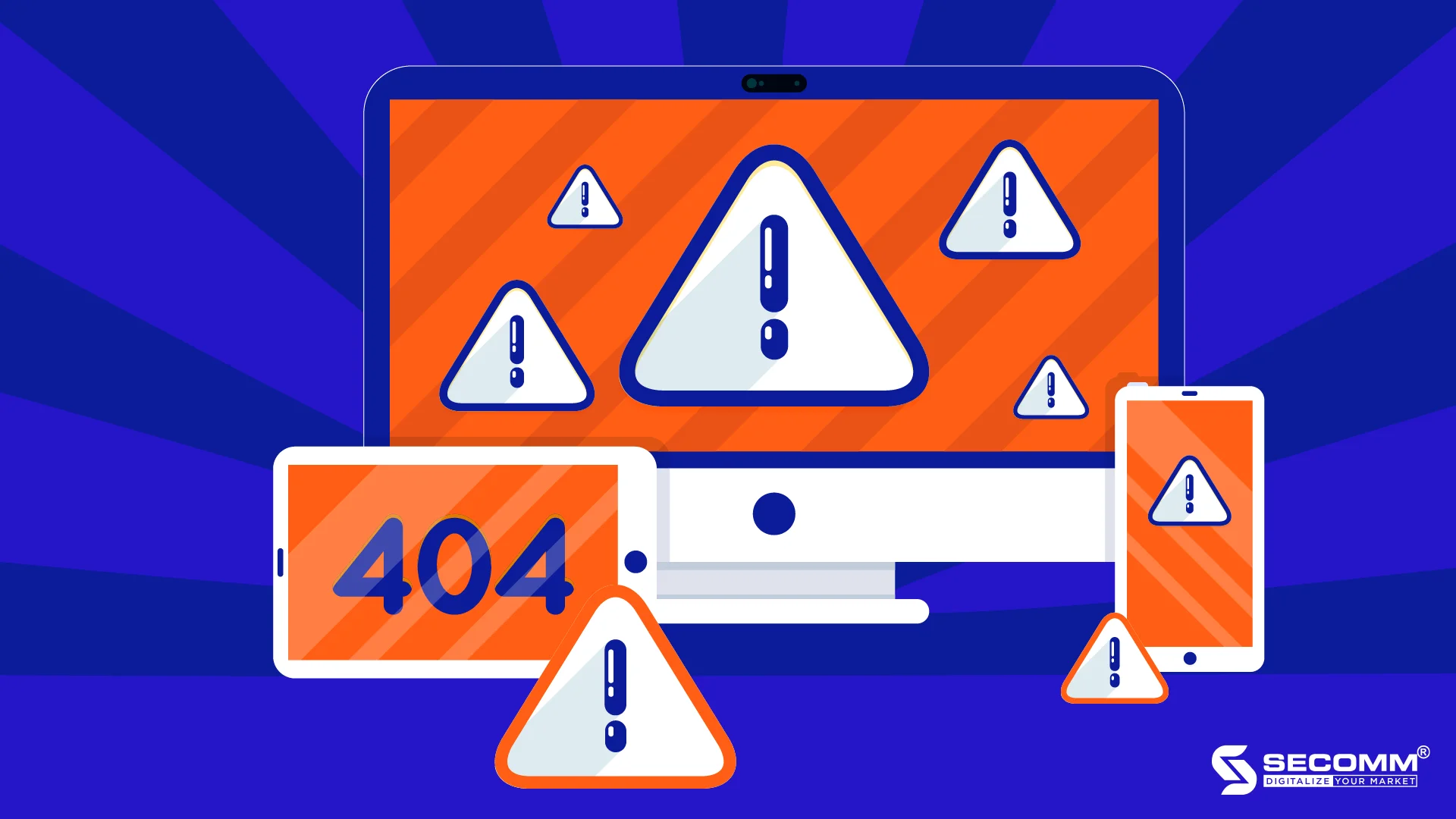
RESOLVING 5 COMMON ERRORS ON ECOMMERCE WEBSITES
A website is a powerful tool for supporting ecommerce (Electronic Commerce) business, serving as a bridge between businesses and customers in the online shopping market, facilitating the entire process of buying and selling goods, and boosting sales. Therefore, building an ecommerce website is crucial for the ecommerce business of a company, requiring not only serious investment but also a long-term strategy.
However, there are still many ecommerce websites facing certain issues that need to be addressed promptly! Here are some common problems:
Low Page Load Speed
To evaluate the speed of a website, tools like Google PageSpeed Insights, WebPageTest, Pingdom Speed Test, Uptrends, etc., can be used.
Scores range from 0 to 100, where 0-49 indicates relatively low speed, 50-89 indicates average speed that needs improvement, and 90-100 indicates excellent speed.
Slow page load speed affects user experience, conversion rates, customer retention, and SEO ranking.
Causes:
- Large product catalogues and diverse products with various attributes.
- Numerous high-resolution images.
- Increasing data in customer information, marketing, content, product catalogue, sales, and operations.
- Hosting quality and configuration issues.
Solutions:
- Compress or resize images, choose efficient image formats (e.g., jpg or .webp instead of .png).
- Utilize browser caching to reduce data load time, optimize the database by minimizing CSS, JavaScript, and HTML, and use tools like CDN/cache to reduce the time to retrieve large amounts of access data.
- Choose hosting providers with suitable caching memory, and web server configurations (Apache/Nginx/PHP/MySQL…), and use CDN to save bandwidth.
Unprofessional Ecommerce Website Interface
Issues with graphic design, colour schemes, inconsistent images and fonts, lack of brand representation, and non-optimal website structure affect the professionalism of the interface.
Consequences:
- Unattractive and unimpressive website interface.
- Reduced professionalism in the eyes of customers leading to decreased customer return rates.
- Decreased user experience, ineffective product search, suggestions, and quick purchase.
Causes:
- Insufficient research on consumer behaviour during the website structure design.
- Lack of expertise in evaluating the aesthetic appeal of the ecommerce website.
Solution:
- Use tools like Google Consumer Surveys, Facebook Audience Insight, and Prisync for market research, customer research, and competitor price tracking.
- Explore design trends such as Dark Mode, Gradient, 3D, and Lai Landing pages.
- Collaborate with experienced interface design providers for an attractive and brand-aligned ecommerce website interface.
Suboptimal Product Categories
Poorly structured product categories and incomplete product information negatively impact the user experience.
Issues:
- Lack of detailed and organized product categories.
- Incomplete product information related to attributes, images, videos, inventory, pricing, promotions, etc.
Consequences:
- Difficulty for customers to search for products.
- Inability to suggest relevant products.
- Prolonged decision-making time for customers, affecting sales.
Solutions:
- Establish a layered category structure, apply filtering and sorting features, and supplement detailed information for each product.
- Implement SEO campaigns for the ecommerce website, including keyword research, category content planning, proper robots.txt configuration, optimized website structure, and URL optimization for category pages.
Lack of Features to Enhance the Shopping Process
Websites should support customer search, and provide convenient and quick shopping processes.
Issues:
- Lack of effective features for searching and suggesting suitable products.
- Inefficient processes in cart addition, checkout, and payment.
Consequences:
- Incomplete shopping experience for customers.
- Slow and complicated purchasing processes lead to reduced conversion rates and revenue.
Causes:
- Absence of a strategic plan for deploying features according to customer buying behaviour.
- Suboptimal implementation by developers.
Solutions:
- Develop a comprehensive strategy with costs and timelines for integrating features into the business model.
- Collaborate with experienced solution providers to ensure successful integration.
Lack of Synchronization with Other Business Systems
Failure to link sales channels (social media, ecommerce platforms, ecommerce websites) with internal business systems like CRM, and ERP for synchronization can lead to misinformation and management difficulties.
Issues:
- Inconsistent information across sales channels.
- Challenges in managing customer, product, order, and store data.
Consequences:
- Impacted online sales due to uncontrolled product/service data.
- Lack of centralized data for reporting, analysis, business forecasting, and customer care activities.
Causes:
- More critical issues in the current ecommerce website system.
- Lack of a suitable strategy regarding costs and time for implementation.
Solution:
- Devise a plan including costs, timelines, and testing methods for the integration of data synchronization functionality into the ecommerce website system.
- Seek solution providers with experience, industry knowledge, and comprehensive services from consultation to development, maintenance, and optimization.
 2
2

 2,221
2,221

 0
0

 1
1
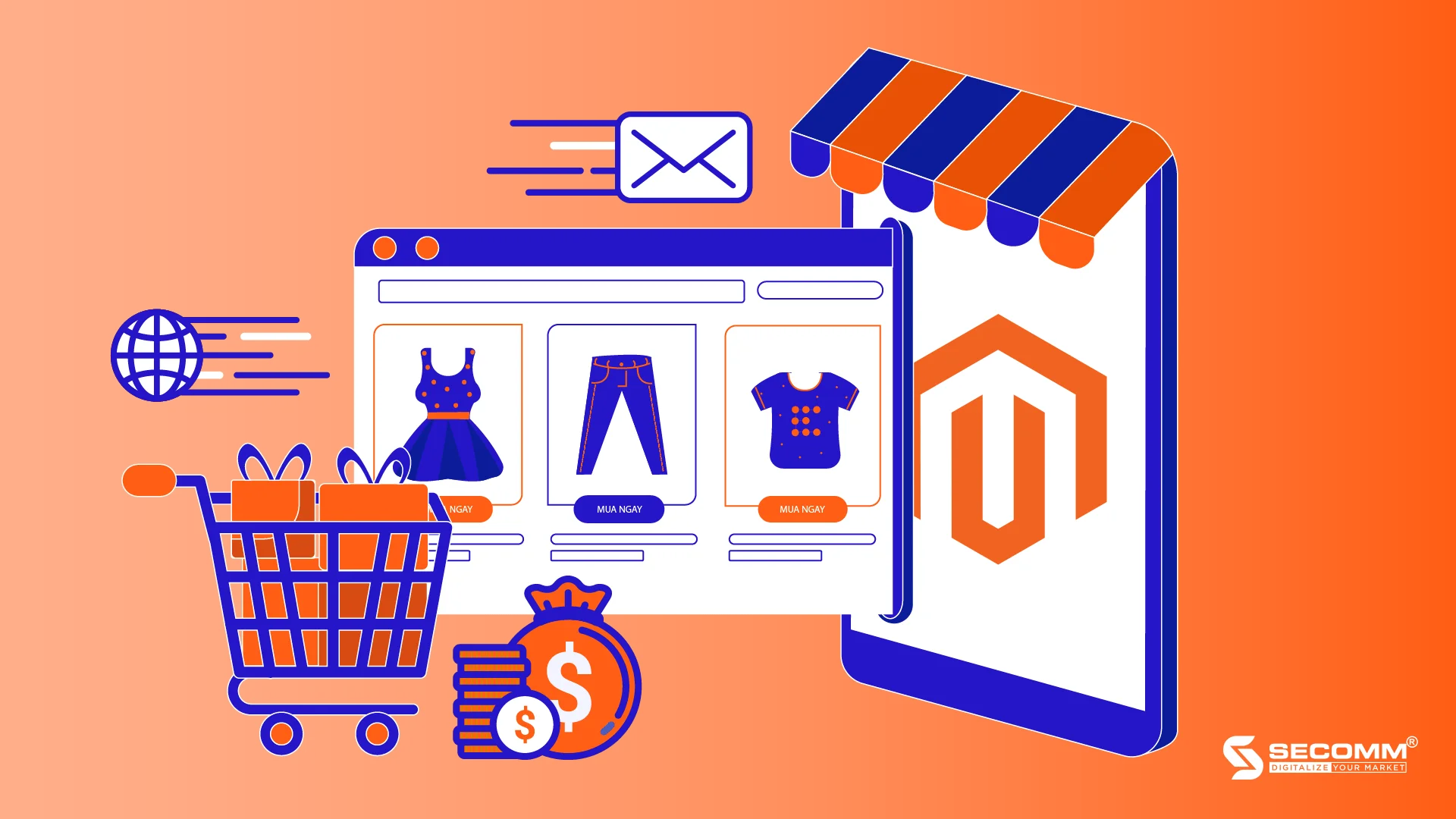
MAGENTO – THE ULTIMATE ECOMMERCE PLATFORM FOR BUSINESS
When deploying an ecommerce website, Magento is the top choice of platform that businesses are aiming for, including global giants like Nike, ASUS, HP, and Burger King, as well as leading Vietnamese enterprises such as Canifa, CellphoneS, Trung Nguyen, and CGV Vietnam.
With outstanding advantages ranging from a diverse ecosystem and flexible customisation capabilities to absolute security, Magento is considered the ‘ultimate boss’ among ecommerce website development platforms today.
So, what are the superior points of Magento?
A ecommerce platform functions from basic to advanced
Magento possesses all the features for a complete ecommerce website:
- Category Management: Control all data and functions related to products, categories, attributes, pricing systems, inventory, images, and videos.
- Content Management: Develop and optimise content for CMS pages (Content Management System), store images, customise themes, and website design.
- Sales Management: Control and operate sales processes, orders, payments, and shipping.
- Marketing Management: Support the building and implementation of marketing programmes with available support tools.
- Customer Management: Manage and collect customer information to enhance the user experience.
- Inventory Management: Continuously meet goods supply for the supply chain with inventory management tools and shipping route navigation.
- Reporting: Exploit data through reporting features on the system to improve and enhance business efficiency.
- Analysis: Support tracking and measuring system performance through integrated tools such as Google Analytics, Facebook Pixels, and Google Tag Manager.
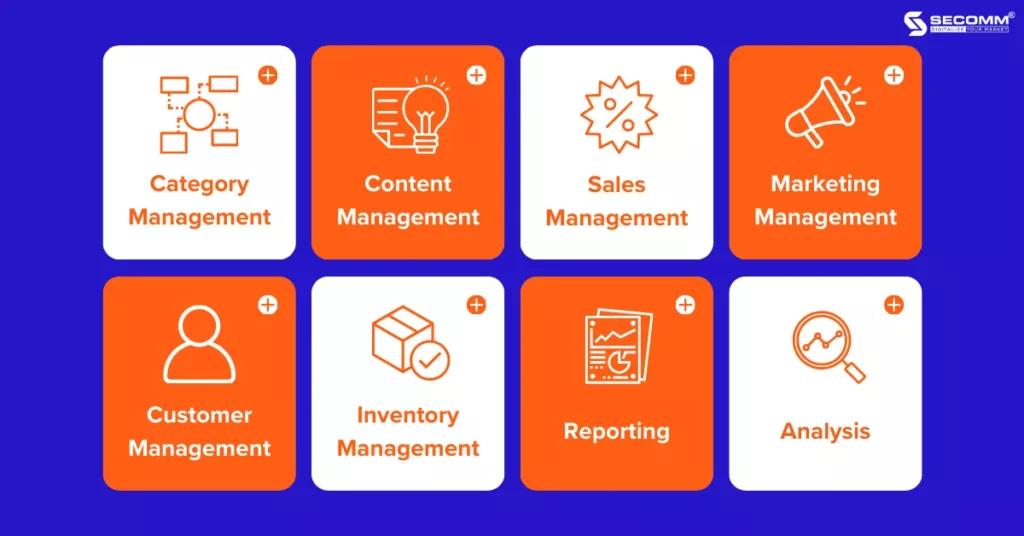
In addition to the basic features of a complete ecommerce website, Magento also owns a diverse system of extensions with many advanced functions in themes, products, marketing, optimal payment solutions, shipping, etc. to meet every operational need and ensure sustainable development of ecommerce for businesses.
When building an ecommerce website, Magento also supports businesses to integrate and link third-party services for efficient ecommerce website operation, such as:
- Payment: Support all forms of payment, from COD, card payments, and e-wallets to online payment gateways, helping businesses diversify the payment experience for customers.
- Shipping: Easily integrate with many shipping units and popular shipping tracking applications to optimise the shipping process for customers.
- Management and operation software: Support the integration of back-office software such as ERP, CRM, POS, etc. to operate human resources more efficiently.
- Business intelligence (BI) analysis tools: Support the integration of business analysis tools such as Power BI, Tableau, and Looker… to improve business strategies for enterprises.
- Omnichannel: Unify all sales channels on the same Magento system to process and control data and seamlessly handle business processes from offline to online.
Furthermore, Magento also has a global technical support community, including many rich experts and professional developers to meet all the requirements of businesses.
High customisation and scalability
The Magento ecommerce website platform possesses all the advantages of open-source software with flexible customisation capabilities to operate the ecommerce website more effectively.
- Customisation: Owning and controlling the entire source code makes it easy for businesses to customise code sections in the system, enabling them to build innovative and improved solutions according to the specific business characteristics of each enterprise.
- Scalability: Magento allows businesses to expand from one website or store to many different websites or stores on the same system. Besides, Magento supports language and currency conversion, helping businesses expand their market to many countries.
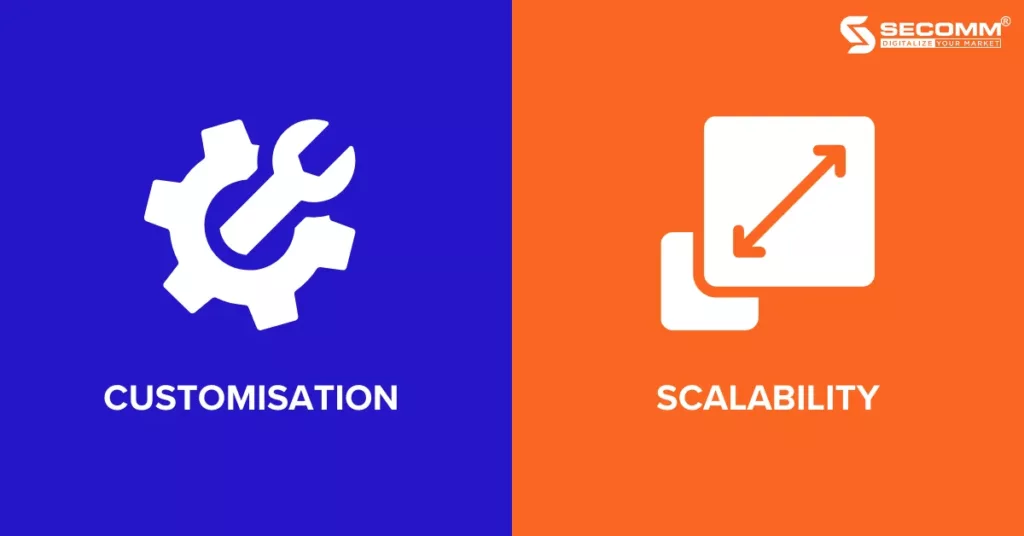
High security
High security is also a superior advantage of Magento compared to other ecommerce website platforms, helping businesses minimise potential risks from data systems and transaction processes on the system.
Some outstanding points of Magento’s security features include:
- Regularly control the system, propose security solutions, and improve website performance.
- Enhanced security for administrators.
- Advanced security for user accounts.
- Ability to block unauthorised bots and codes.
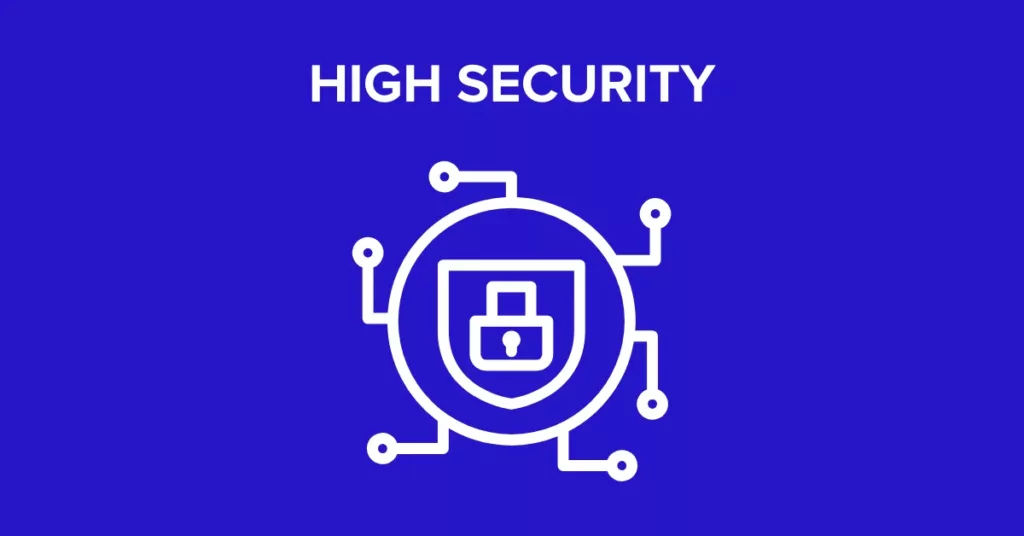
With the advantages of having all ecommerce website functions, from basic to advanced, high customisation capabilities, and high security, Magento is the top choice for businesses when deploying an ecommerce website system. However, issues related to costs, time, and the requirement for a highly specialised technical team make it challenging for many businesses to implement an ecommerce website system with Magento.
Contact SECOMM now for FREE CONSULTATION SUPPORT!
 2
2

 2,499
2,499

 0
0

 1
1
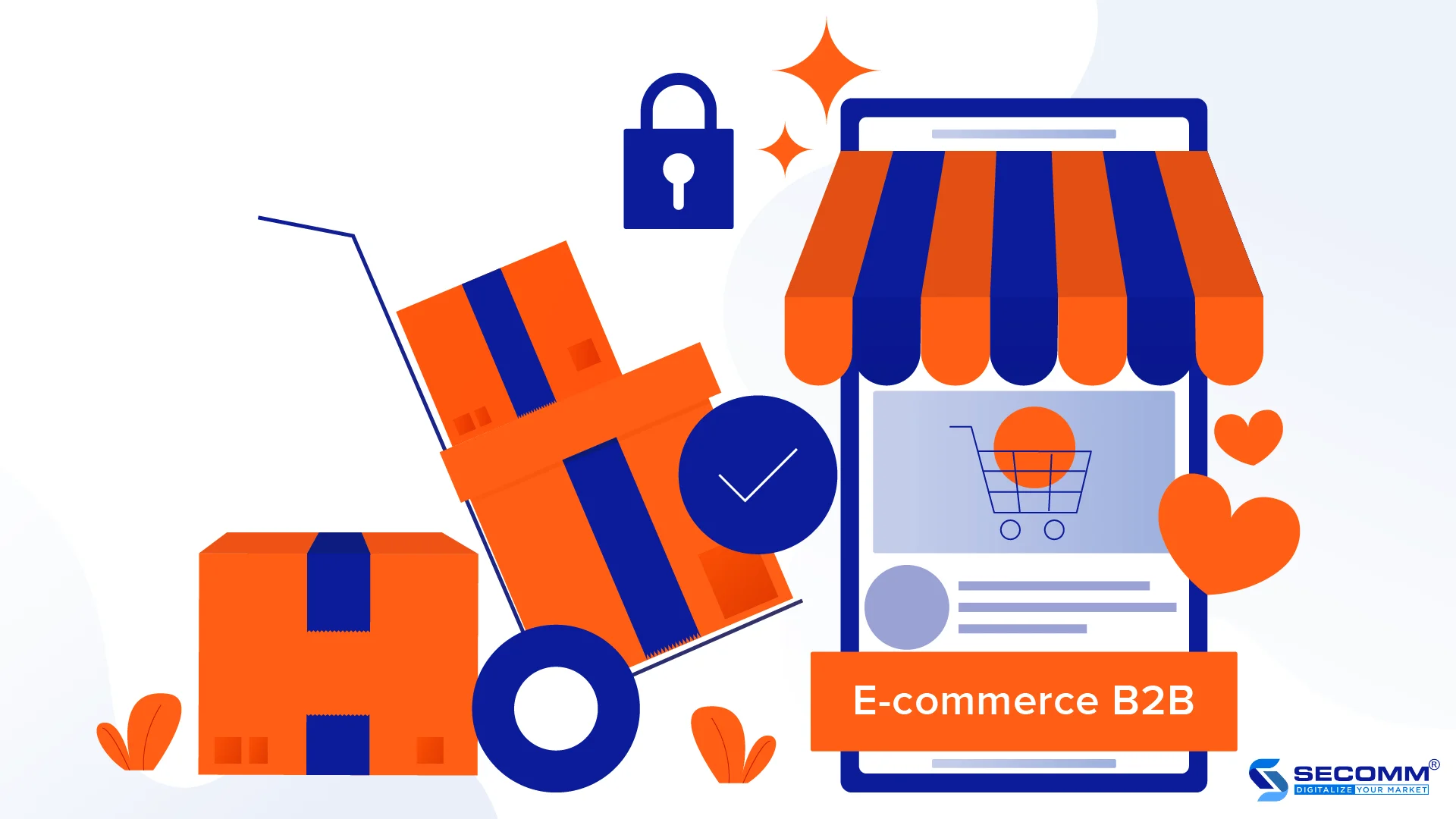
REASONS WHY B2B ECOMMERCE SHOULD BECOME A MUST-DO TREND!
The recent Covid-19 pandemic has influenced a shift in the purchasing behaviour of consumers, including businesses in the manufacturing and wholesale markets of B2B. It has prompted businesses to gradually transition from traditional business models to Business-to-Business (B2B) ecommerce.
B2B ecommerce involves online business transactions between two enterprises. According to “The Ultimate B2B Ecommerce Guide: Tradition is out. Digital is in,” published by DHL Express, it demonstrates the significant potential of the B2B ecommerce market, projecting a growth of over 70% by 2027, equivalent to 20.9 trillion USD.
Why should businesses implement B2B ecommerce now?
Better Customer Support
B2B ecommerce supports faster order placement for customers with:
A structured product catalogue interface, making product searches easier. Adding/removing products from the cart and automatically calculating the total cost makes order control more convenient. Features like keyword search, quick product filtering, fast cart access, and speedy checkout facilitate the online shopping process for customers.
Traditionally, B2B customers faced barriers in the invoicing process and traditional payment methods. Nowadays, payments in B2B ecommerce occur more quickly. Businesses can easily set up electronic invoices for data management. Customers have various payment options: Cash, Bank Transfer, Internet Banking, E-wallets, Installments, or Regular Payments. The payment process takes place on the phone or computer with an internet connection.
B2B ecommerce helps businesses reach more potential customers with:
Ecommerce websites support online shopping consultation with features like Live Chat (direct communication with customers) and Chatbox (answering frequently asked questions without the need for a consultant).
Simplified registration process, only requiring online form registration (information collection and customer shopping needs) and the creation of electronic contracts for transaction signing.
In B2B ecommerce, detailed information on product prices and pricing policy changes is always updated on the website.
Internal System Improvement
In the sales system
Order processing speed is faster thanks to:
- Order data, such as order status, responsible personnel, payment methods, etc., are stored in the system, resulting in faster error resolution.
- Minimization of errors from manual processes (using word processors, Excel spreadsheets, etc.).
Sales processes are automated through:
- The Auto Email feature helps automatically send order confirmations, invoices, shipping, and credit documents.
- Businesses can automatically pay for regularly placed orders to save time.
- Customer support in B2B ecommerce is as vital as Email Marketing, helping businesses gather customer reviews, introduce new products, and announce promotions.
In the operations system:
Production costs are reduced by producing according to customer orders instead of mass production. Additionally, it saves costs for premises, paperwork, printing, etc.
Improved post-sales services:
- Order preparation: Utilizing automation technology for faster product packaging.
- Inventory management process: Using inventory management software to check products, attach labels/barcodes, classify, and set up product storage categories to operate the warehouse more efficiently, resulting in faster deliveries.
- Building a distribution system: Identifying suitable locations to rent/build warehouses to save transportation time and manage inventory.
Building a return/exchange policy:
- Applicable cases: Checking system data on the time, status, and validity of goods.
- Methods of exchange/return: Customers can return goods by mail, courier services, or in person.
- Refund methods: Online payments via domestic ATMs, Visa/Mastercard, E-wallets.
Regarding the personnel system:
Ecommerce B2B websites operate 24/7 with almost no staff, optimizing personnel costs. Additionally, the B2B ecommerce system supports businesses in assigning tasks and managing the progress of employees.
Exploiting and Analyzing Customer Data
What data is exploited?
- Marketing: Sales channels, communication, campaigns, etc.
- Content: Text, and images that drive customer shopping behavior.
- Customers: Demographics, hobbies, consumer behaviour, etc.
- Sales: Sales volume, order information, etc.
- Operations: Payment processes, delivery processes, etc.
What can be done with this data?
Reporting:
- Marketing reports based on cart status searched keywords, etc.
- Sales reports on orders, taxes, invoices, shipping, refunds, payments, etc.
- Customer reports are based on the value of orders, order quantity, favourite products, customer segments, etc.
- Product reports on product views, best-selling products, inventory levels, customer reviews, etc.
Support business analysis and forecasting based on the collected data. Determine how factors are influenced by various elements.
Implement personalized experiences: Personalized emails, and product recommendations.
Improve revenue based on the received reports and analysis:
- Improve the interface, and structure of the website to align with customer shopping behavior, such as banner position, CTA buttons, recommended products, etc.
- Marketing campaigns: Focus on high-converting sales channels, Email Marketing for customers about unpaid items in the cart, etc.
Plan long-term business development strategies. Introduce improvements to new products and associated services (payment, shipping, etc.).
In summary, B2B ecommerce contributes to improving business models, boosting sales, and expanding the sales network for enterprises. However, implementing B2B ecommerce is still new to many B2B business owners, and they may not know where to start and how to improve the ecommerce system!
As an expert in providing comprehensive ecommerce solutions, SECOMM supports B2B enterprises with:
- Ecommerce Consultation: Advising on technology solutions and resources to develop a suitable ecommerce business strategy.
- Ecommerce Development: Providing professional B2B ecommerce system development services using Magento or as per requirements.
- Ecommerce Care: Offering maintenance and system upgrade services, such as hosting and system maintenance, and App system care.
- Ecommerce Growth: Providing ecommerce growth services such as Omnichannel, Ecommerce Marketing, and SEO.
Contact SECOMM now for FREE CONSULTATION SUPPORT!
 2
2

 5,179
5,179

 0
0

 1
1
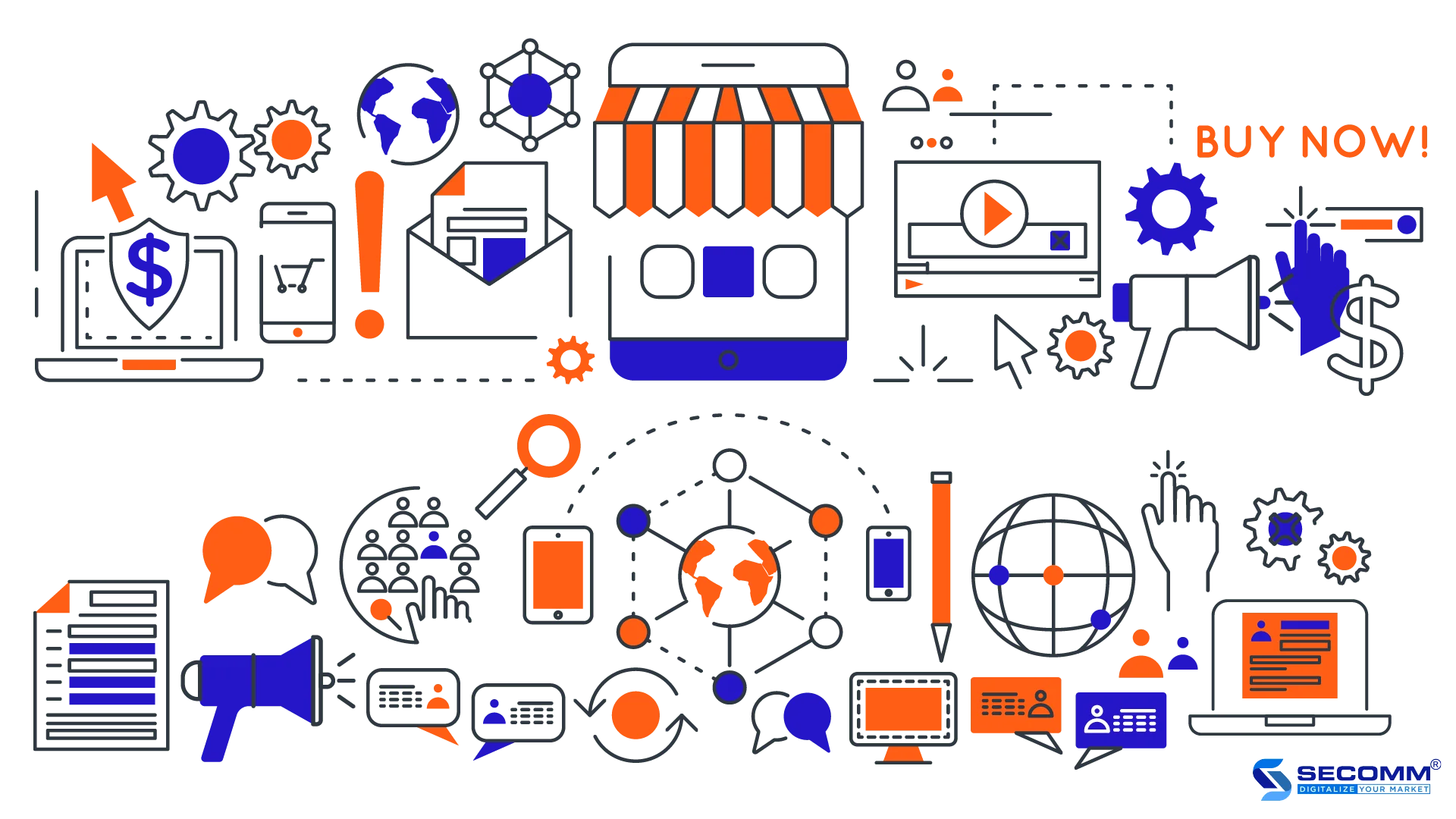
B2B ECOMMERCE: WHY YOU SHOULD IMPLEMENT IT?
Business-to-Consumer (B2C) ecommerce is online transactions between businesses and consumers.
B2C ecommerce is considered a potential market for Vietnamese businesses at present. According to the 2020 Ecommerce White Paper, B2C ecommerce in Vietnam reached 11.8 billion USD, ranking 3rd in the ASEAN region, with a 41% increase in new participants, the highest in the region.
This type of ecommerce is currently popular with a global scale of 4,280 billion USD in 2020. Examples include the B2C websites of Mobile World (Top 5 with 16,606,700 visits), Bach Hoa Xanh (Top 9 with 5,440,000 visits), and FPT Shop (Top 10 with 4,213,300 visits).
Why do businesses need to implement B2C ecommerce?
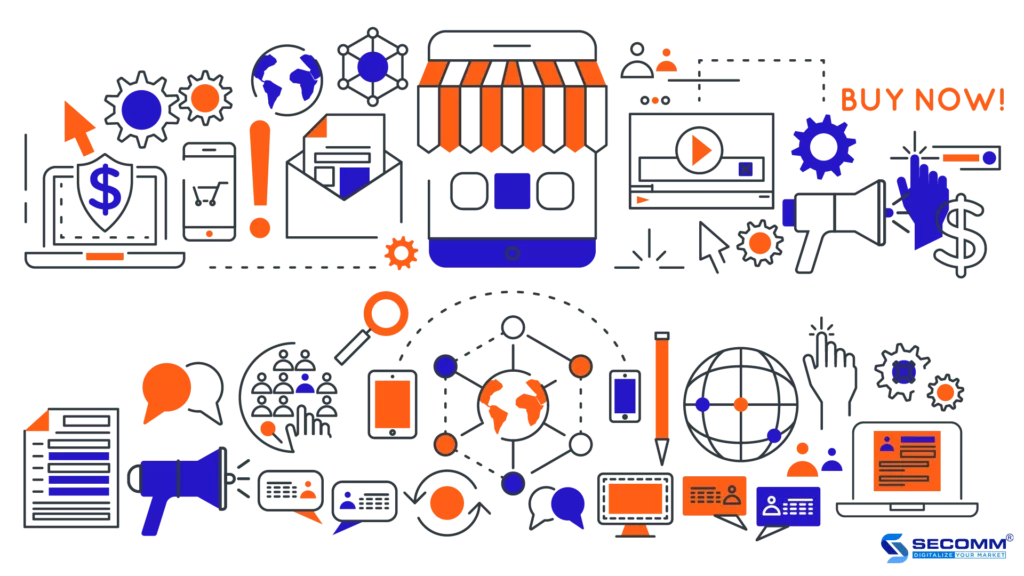
B2C Ecommerce: Maximize business and brand positioning
Changes in consumer shopping habits have influenced the B2C ecommerce market. Customers tend to spend on brands in the online market rather than shopping and experiencing directly at physical stores. Therefore, implementing B2C ecommerce helps not only to position the brand in the market but also to maximize revenue and profit for businesses.
Brand positioning
Effective Ecommerce Marketing campaigns help businesses reach more potential customers. On popular social media platforms (Facebook, Instagram, TikTok, Zalo), businesses can reach customers through advertising tools and directly interact with customers, supporting the brand’s presence in the subconscious of customers. Additionally, customer search habits for product information help businesses that have implemented SEO and SEM attract a large amount of traffic to their ecommerce websites, increasing the conversion rate of orders.
Maximize revenue
Establishing an additional online sales channel helps businesses maximize revenue. Unlike physical stores, ecommerce websites operate 24/7, supporting customers in shopping at any time. They also provide features to facilitate the online shopping process for consumers, such as quick search, product comparison, fast cart, recommended products, and quick payment. This speeds up the online shopping process, improves order conversion rate, and boosts business sales.
Moreover, in 2020, businesses that implemented B2C ecommerce demonstrated its importance when social distancing due to Covid-19 occurred. B2C businesses with ecommerce maintained their business activities compared to traditional businesses.
Minimize costs
With the nature of unlimited time and location for shopping, online stores help businesses solve cost-related problems more effectively.
- Save fixed costs: Costs such as rent, personnel…
- Reduce variable costs: Apply advances in online payment, E-logistics, Marketing, etc., to minimize business operation costs.
- Reduce intermediary costs: Directly transact with customers through the Internet, reducing dependence on intermediary channels like traditional models.
B2C Ecommerce: More efficient data exploitation and analysis
In the current era of “Big Data,” data plays a crucial role… When deploying their ecommerce systems, businesses can easily:
Synchronize data about:
- Marketing: Advertising, communication, sales channels…
- Content: Images, messages on the website or Marketing campaigns…
- Customers: Shopping behaviour, potential customer segments
- Sales: Revenue, order quantity per campaign…
- Operations: Payment process, delivery process…
Report and analyse business:
- Marketing is based on the effectiveness of each campaign, searched keywords, etc.
- Sales in terms of sales, orders, payments, taxes, etc.
- Customer based on shopping history, order value, favourite products…
- Products based on customer reviews, best-selling products, product views…
Business forecasting: Examine scenarios that data has shown regarding developments in the B2C ecommerce market, thereby devising more suitable business strategies.
Business development and direction: Upgrade B2C ecommerce systems to adapt to market changes. Introduce innovations in new products and accompanying services (payment, shipping…).
B2C Ecommerce: Better business management
When a business successfully transitions to the B2C ecommerce business model, issues related to sales, marketing, and operations are improved.
For Sales and Marketing systems
Automate the sales process:
- Automatically collect customer data.
- Automatically process orders: Order creation, store selection, automatic storage location selection.
- Automatically receive and respond to common issues through features like Livechat, and Chatbot.
- Automatically send order confirmations, generate invoices, and handle shipping through features like Auto Email…
Order processing speed is faster:
- Order processing for faster delivery from order creation, order picking, packaging, and delivery.
- Faster error handling: All data is stored on the system, so handling arising errors is faster.
- Minimize errors from manual processes.
Improve Marketing campaigns:
- Build suitable Marketing: Use social media to reach customers, SEM & SEO to increase website traffic, Ecommerce Marketing to increase conversion rates…
- After-sales, ensure customer retention rate: Email Marketing about unpaid orders in the cart, promotional programs…
Improve Customer Support:
Personalize the user experience at each stage through:
- Website: Structure, interface, features (Chatbox & Livechat)…
- Email: Personalize the sender’s name, and desired service/product.
- Telesale: Based on data to sell suitable products and services.
Build better return/exchange policies:
- Applicable cases: Check system data on time, and validate product status.
- Return/exchange methods: Customers send returns by mail, courier services, or directly.
- Refund methods: Online payment via local ATM, Visa/Mastercard, or E-wallet.
For Operations systems
- Prepare orders: Use warehouse management software to check goods, label/barcode, categorize, and set up product storage categories to operate the warehouse scientifically, thereby speeding up delivery.
- Packaging: Apply mechanization technology to package products faster.
- Delivery: Map location technology helps build delivery routes for shippers, and delivery times are faster. Example: Tiki’s 2-hour delivery or Hasaki.
- Warehouse management system: Identify suitable locations to rent/build warehouses to save transportation time and inventory management.
After understanding the importance of B2C ecommerce for business development, the next important thing businesses need to do is learn about effective and flexible methods to deploy this system.
With more than 9 YEARS OF EXPERIENCE providing comprehensive ecommerce solutions for many businesses in various countries, SECOMM provides solutions such as:
- Ecommerce solution consulting: Consult on technology solutions and resources to develop a suitable B2C ecommerce business strategy.
- B2C ecommerce system development: Provide professional B2C ecommerce system development services using Magento or according to requirements.
- B2C ecommerce system care: Provide maintenance and system upgrade services for B2C ecommerce systems, such as hosting and system maintenance services, and app system care.
- B2C ecommerce growth: Provide B2C ecommerce growth services such as Omnichannel, Ecommerce Marketing, and SEO.
Contact SECOMM now for FREE CONSULTATION SUPPORT!
 2
2

 4,817
4,817

 0
0

 1
1
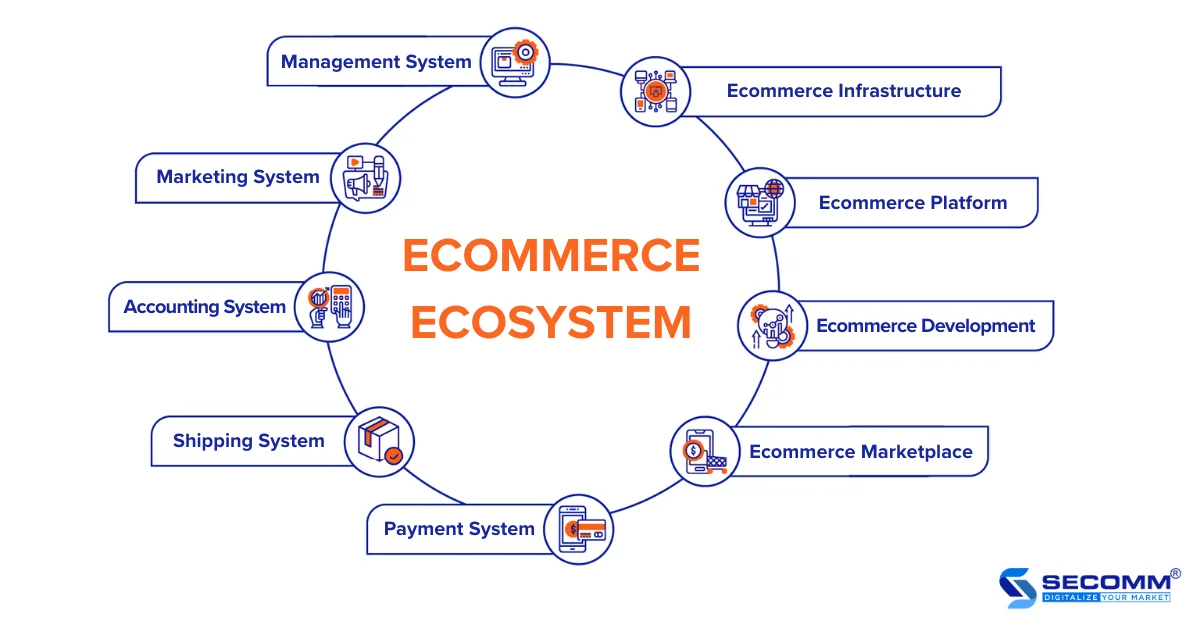
ECOMMERCE ECOSYSTEM: A CHALLENGE FOR VIETNAMESE BUSINESS
The ecommerce (Electronic Commerce) ecosystem is an open space that facilitates all interactions, connecting human factors, social elements, and information technology platforms with applications and services to provide value and efficiently operate components within the ecosystem. So, what are the components of the ecommerce ecosystem?
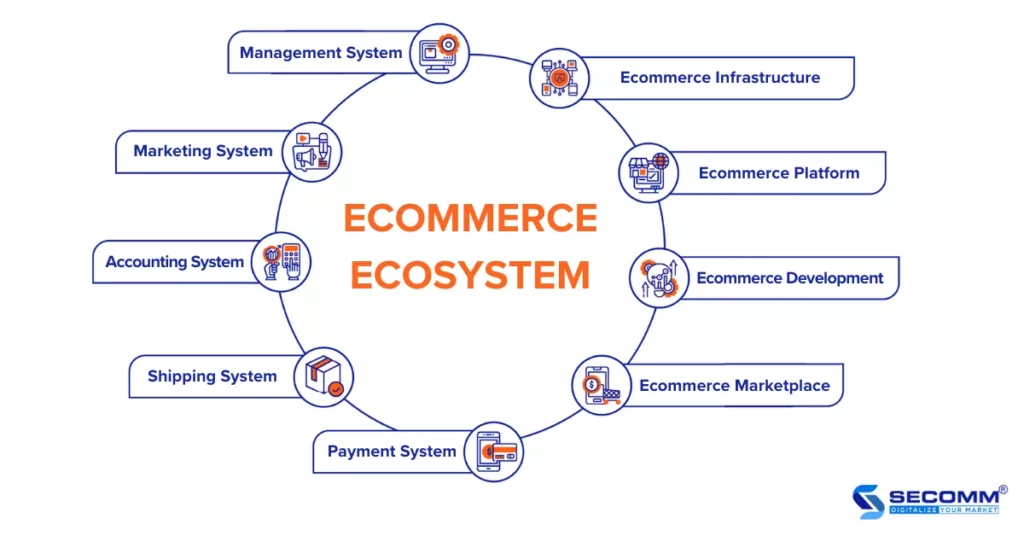
Ecommerce Ecosystem: Infrastructure
The system includes hardware (servers and devices), software (services/tools for management, and analysis), network systems, and physical facilities that form the foundation for the remaining components, ensuring smooth and efficient ecommerce processes.
Ecommerce Ecosystem: Ecommerce Platform
Software applications are used to build and manage all activities within the system. Currently, businesses often use platforms such as Magento, Shopify, BigCommerce, WooCommerce, Haravan, and Wix to create ecommerce websites.
Ecommerce Ecosystem: Ecommerce Development Services
Provides services and solutions for developing websites, systems, and ecommerce processes. Some popular ecommerce solution providers in Vietnam include SECOMM, SmartOSC, Isobar, etc.
Ecommerce Ecosystem: Ecommerce Marketplace
Provides an environment and all the services supporting ecommerce, allowing easy buying and selling between multiple sellers and buyers. Popular ecommerce marketplaces in Vietnam include Shopee, Lazada, Tiki, Sendo, etc.
Ecommerce Ecosystem: Payment System
Includes networks, systems, and devices processing all transactions within ecommerce. In addition to common payment methods such as cash, card payments (domestic cards, Visa, Mastercard, etc.), payment gateways (OnePay, PayPal, etc.), and e-wallets (Momo, ZaloPay, etc.) are developing in Vietnam.
Ecommerce Ecosystem: Shipping System
The shipping system includes all processes for managing, distributing goods from warehouses, packaging, and delivering to customers. Popular shipping service providers in Vietnam include Giao Hàng Tiết Kiệm, Giao Hàng Nhanh, ViettelPost, J&T, Ahamove, etc.
Ecommerce Ecosystem: Accounting System
Supports businesses in managing data related to invoices, sales revenue, and all financial flows in ecommerce activities. The emergence of e-invoicing software such as E-Invoice, MISA meInvoice, FPT.eInvoice, etc., has greatly supported accounting processes.
Ecommerce Ecosystem: Marketing System
Marketing activities support effective brand and product development, reaching and personalizing customer experiences through strategies, channels, and supporting tools.
Ecommerce Ecosystem: Management System
Uses resource management and operational process management software to enhance seamlessness and efficiency for the entire ecommerce system. Commonly used management systems include ERP, CRM, IMS, POS, OFM, etc.
In general, the components of the ecom ecosystem operate through a system of mechanisms, policies, and consistent laws to form a secure electronic data exchange system, ensuring the rights and responsibilities of businesses and consumers.
To achieve outstanding and sustainable growth, besides optimizing opportunities, businesses need to build a complete for themselves, creating a platform to enhance interactions between businesses, the market, and users more robustly. However, most Vietnamese businesses still face many challenges in building their ecommerce business plans. The majority of businesses have not correctly identified the necessary and appropriate components for their business models, leading to issues related to deployment time and budget constraints.
 2
2

 5,270
5,270

 0
0

 1
1
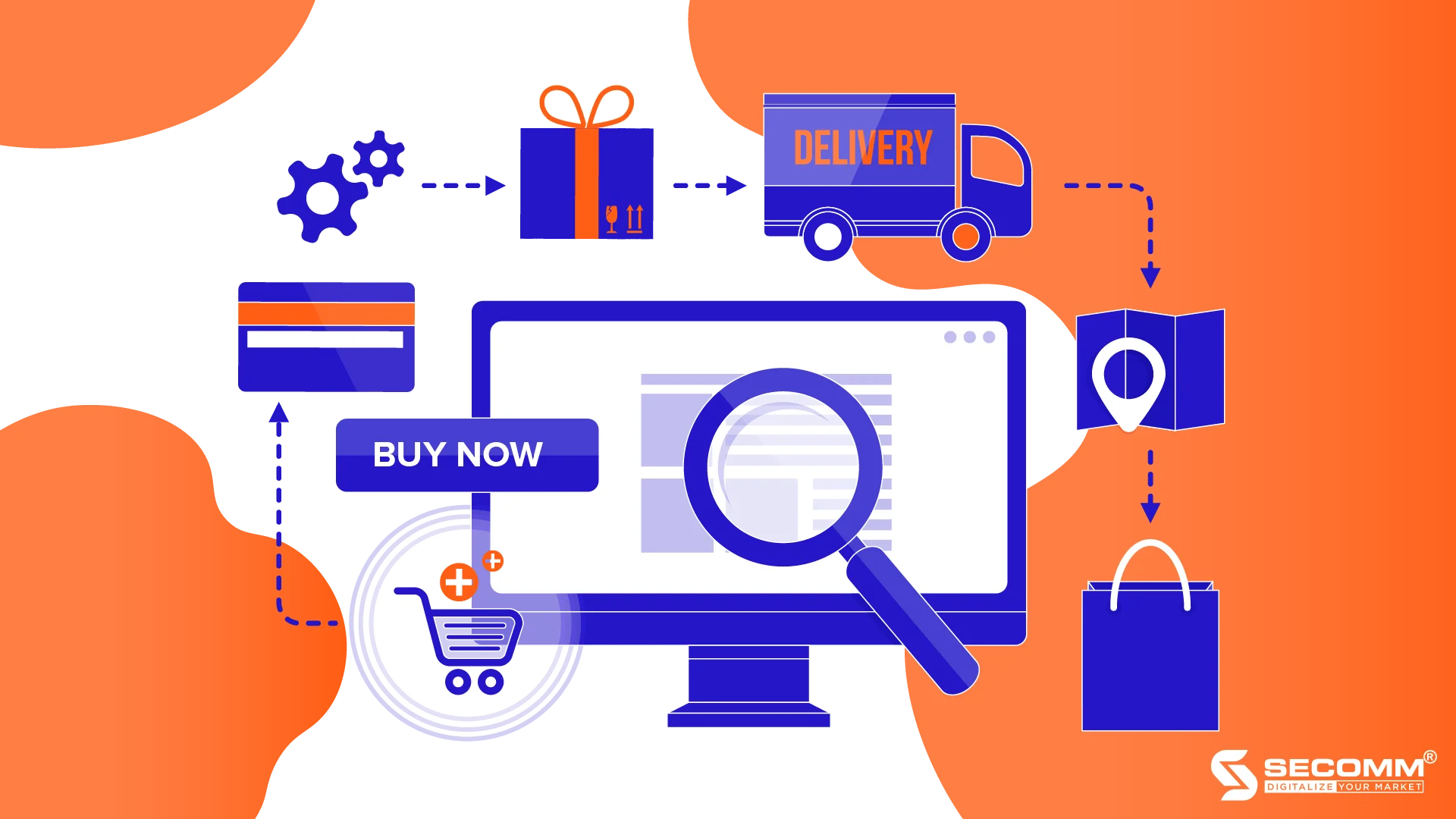
20 METRICS TO MEASURE ECOMMERCE BUSINESS
Frequent monitoring of metrics in business allows a deeper understanding of customers and quantifies important aspects of the business. Particularly in ecommerce (Electronic Commerce), measuring these indices is even more crucial as they assist businesses in assessing existing risks and opportunities in the market.
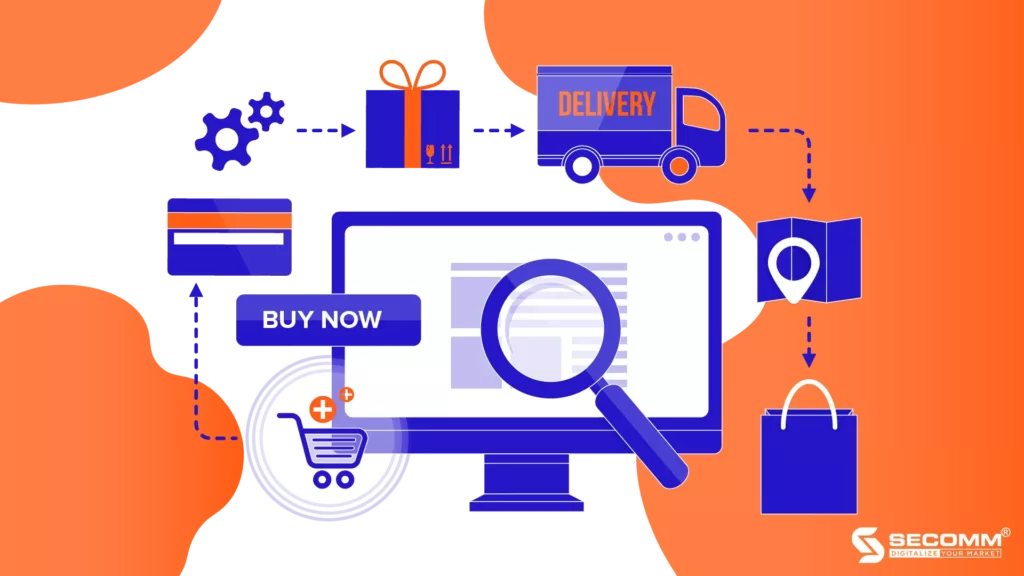
MEASURE ECOMMERCE: SALES
Gross Profit Ratio (GP)
Indicates how much profit is generated for every dollar of revenue.
Formula: Gross Profit Ratio (%) = Gross Profit / Revenue
Cost of Goods Sold (COGS)
The value of goods sold or consumed during a specific period.
Formula: Cost of Goods Sold = Beginning Inventory + Additional Purchases During the Period – Ending Inventory
Average Order Value (AOV)
The average amount a customer spends when shopping on an ecommerce website.
Formula: Average Order Value = Revenue / Number of Orders
Revenue Per Click (RPC)
Average revenue based on the conversion rate each time a customer visits an ecommerce website.
Formula: Revenue Per Click = Revenue / Number of Visits
Customer Lifetime Value (CLV)
The value a customer contributes to a company over their entire lifetime.
Formula: Customer Lifetime Value = (Transaction 1 + Transaction 2 + Transaction 3 + …Transaction n) x Average Profit Margin
Purchase Frequency
Indicates the average number of times a customer purchases within a specific period.
Formula: Purchase Frequency = Total Orders / Total Customers
Time Between Purchases (TBP)
Measures the time between consecutive purchases by a customer.
Formula: Time Between Purchases = Purchase Frequency / 365
Shopping Cart Abandonment Rate (CAR)
Measures the number of customers who added items to their cart but did not complete the purchase.
Formula: Cart Abandonment Rate = 1 – (Completed Transactions / Carts with Products) x 100
Cost of Acquiring Customer (CAC)
The cost associated with persuading consumers to purchase a company’s products or services.
Formula: Cost of Acquiring Customer = Total Cost / Number of New Customers
Repeat Purchase Rate (RPR)
Indicates the likelihood of customers returning to make a second or subsequent purchase.
Formula: Repeat Purchase Rate = Number of Repeat Purchases / Total Number of Purchases
MEASURE ECOMMERCE: MARKETING
Website Traffic
Refers to the total number of visits to an ecommerce website.
Traffic Source
Identifies the primary sources directing traffic to your website.
Time on Site (TOS)
Indicates the average time a visitor spends on the website.
Average Session Duration
The average time users spend in a single session.
Formula: Total Session Duration / Number of Sessions
Page per Visit
Measures the level of content engagement, indicating how deeply users explore information on the website.
Formula: Pages per Visit = Number of Pages Viewed / Visits
Bounce Rate
The percentage of single-page visits where visitors leave without clicking on any other content.
Formula: Bounce Rate = Total Bounces in a Period / Total Visits in that Period
Click Through Rate (CTR)
The rate at which customers view and click on a business’s advertisements.
Formula: Click Through Rate = Number of Clicks / Number of Impressions
Engagement Rate
Indicates the number of people who interacted with a company’s content through various ecommerce channels such as the business’s ecommerce website/app, ecommerce platforms, Facebook, Instagram, TikTok, etc.
Formula: Social Media Engagement = Number of Interactions / Number of Followers
Pay-Per-Click (PPC)
The Internet marketing model is where businesses pay a fee each time their ads are clicked.
Formula: Pay-Per-Click Cost = Advertising Cost / Number of Clicks
Conversion Rate (CR)
Measures the ratio of potential customers who become actual customers by making a purchase.
Formula: Conversion Rate = Number of Conversions / Total Ad Interactions
 2
2

 10,009
10,009

 0
0

 1
1
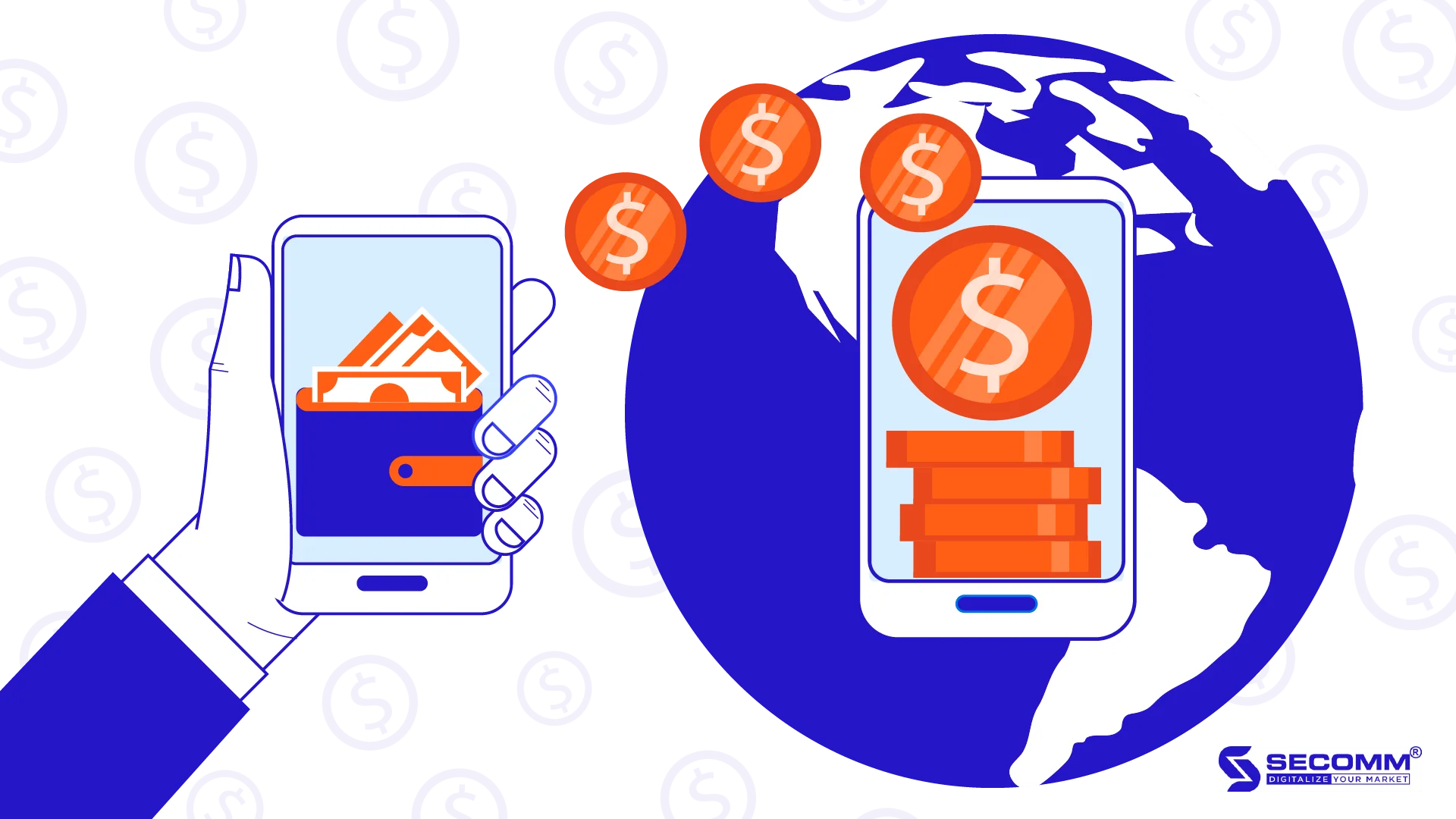
TOP 7 PAYMENT METHODS IN ECOMMERCE
Payment services play a crucial role in ecommerce. Diversifying payment methods can provide a more complete shopping experience for consumers, maximise revenue, and enhance the brand for businesses.
Here are some payment methods in ecommerce:
COD (Cash On Delivery): Pay upon receiving the goods
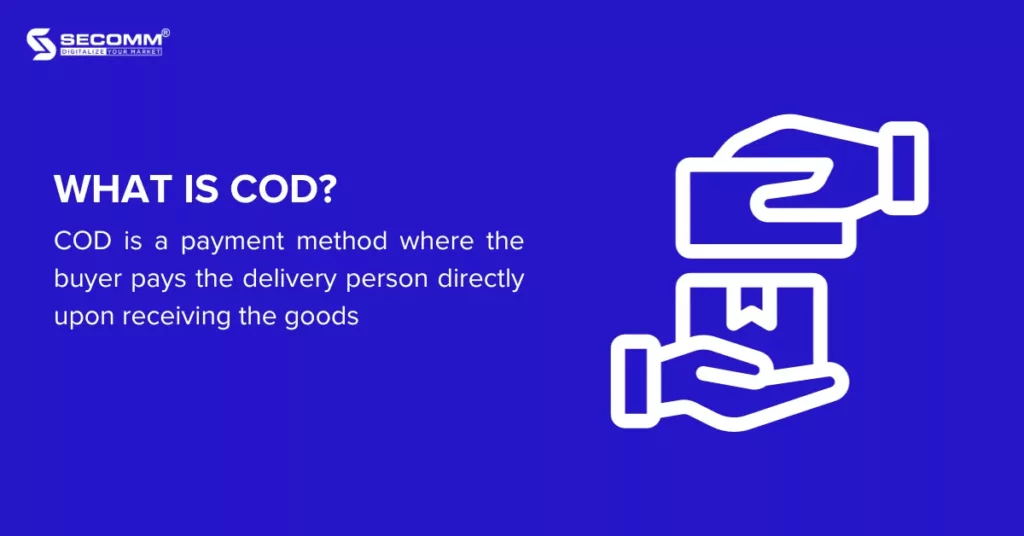
COD is a payment method where the buyer pays the delivery person directly upon receiving the goods. Buyers don’t have to pay in advance when placing an order, and if the products are not satisfactory, they have the right to refuse and return the items.
- Popularity: 78% (2020)
- Benefits:
- Sellers:
- Build trust with customers when shopping online.
- It boosts orders and increases revenue as buyers don’t have to pay upfront.
- Buyers:
- Allow payment after checking the products, helping customers avoid receiving unwanted items.
- Limit the risk of personal or card information theft on websites with weak security.
- Sellers:
Bank transfer
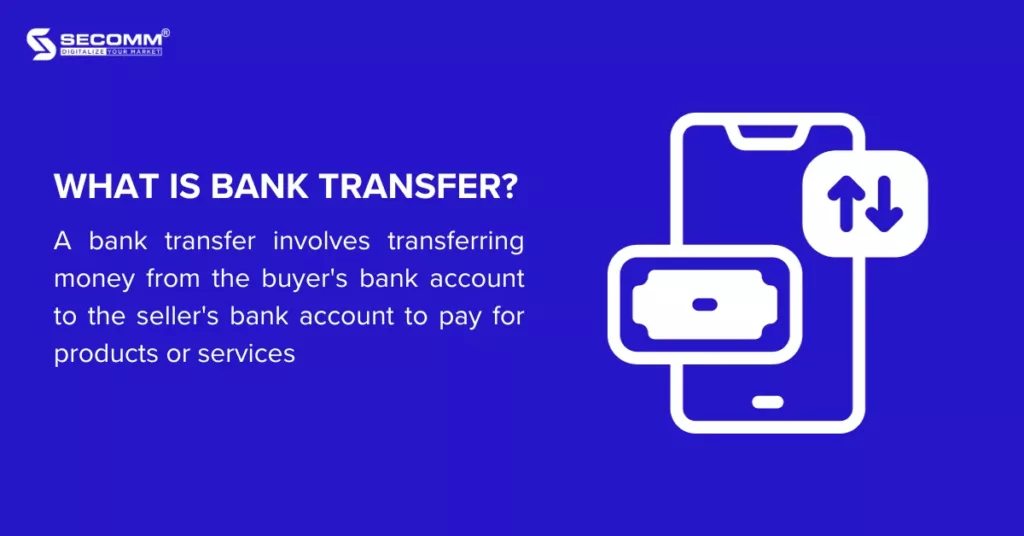
A bank transfer involves transferring money from the buyer’s bank account to the seller’s bank account to pay for products or services. Modern bank transfer methods, such as Internet Banking and Mobile Banking are replacing traditional ATM transfers.
- Popularity: 39% (2020)
- Benefits:
- Quick transactions through Internet Banking or Mobile Banking.
- It saves shopping time.
- Easy control of transaction information.
- Limits the risks associated with using cash, such as theft.
Online payment gateways
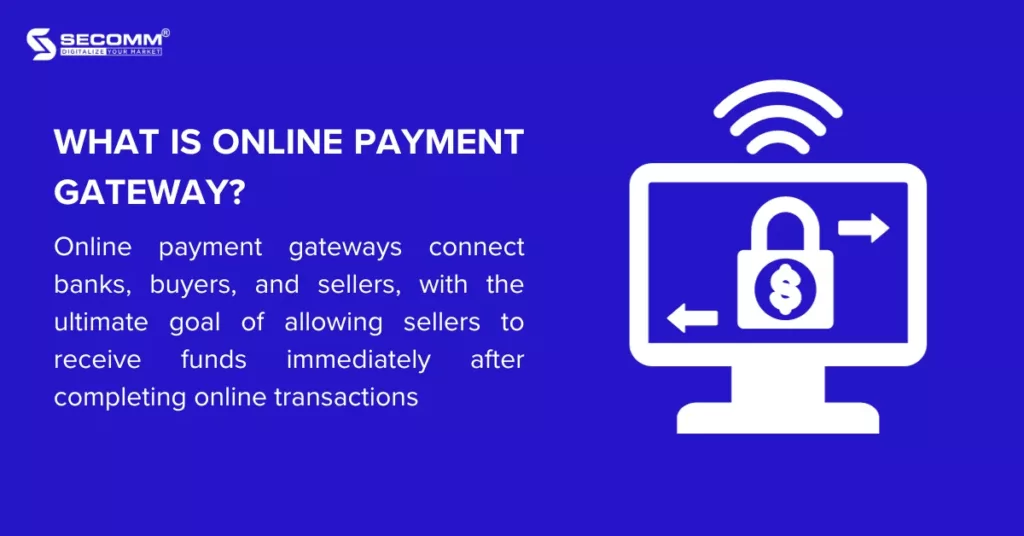
Online payment gateways connect banks, buyers, and sellers, with the ultimate goal of allowing sellers to receive funds immediately after completing online transactions. These gateways accept domestic debit cards, credit cards, and ATM cards. Popular gateways in Vietnam include VNPay, ZaloPay, Payoo, Paypal, OnePay, etc.
- Popularity: 23% (2020)
- Benefits:
- Faster payment processes.
- It helps customers save time.
- Reduce the risks associated with cash transactions.
- High information security due to strict security standards.
- Provide detailed payment history for effective transaction management.
E-wallets

E-wallets are online payment accounts used for various online transactions. Payments through e-wallets are made by linking the account to a bank account, depositing money into the wallet, and then making simple and convenient payments for linked services. Some popular e-wallets in Vietnam include Momo, ZaloPay, etc.
- Popularity: 20% (2020)
- Benefits:
- Convenient smartphone payments.
- Save transaction time.
- Reduce the risks associated with cash transactions.
- Easy and safe account checking and management.
- Low usage fees for financial transactions compared to other features with the same functionality.
Scratch cards
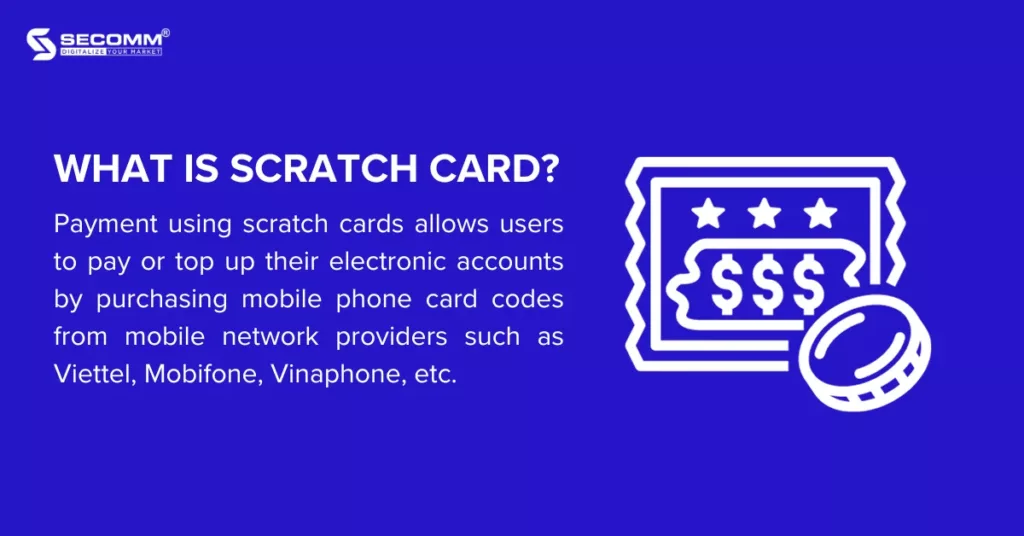
Payment using scratch cards allows users to pay or top up their electronic accounts by purchasing mobile phone card codes from mobile network providers such as Viettel, Mobifone, Vinaphone, etc. However, this payment method is usually only applicable to specific ecommerce platforms and websites.
- Popularity: 6% (2020)
- Benefits:
- Quick payments at various price points (20,000 VND, 50,000 VND, 100,000 VND, etc.).
- Reduce the risks associated with cash transactions.
Brand-specific cards/wallets
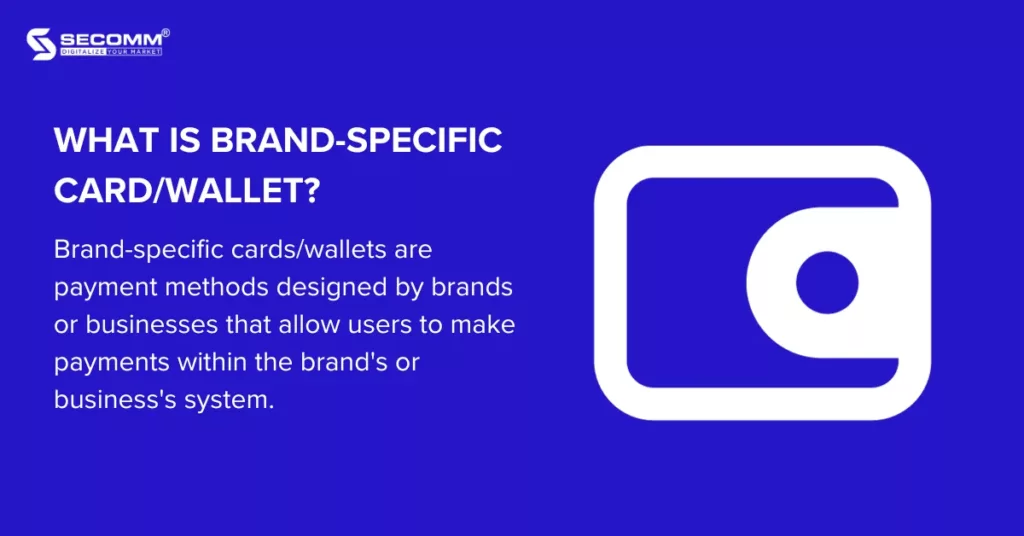
Brand-specific cards/wallets are payment methods designed by brands or businesses that allow users to make payments within the brand’s or business’s system. Examples include Shopee’s wallet, Lazada’s eM wallet, Starbucks’ card, VinGroup’s VinID, etc.
- Popularity: This payment method has only recently started gaining popularity, particularly among large brands.
- Benefits:
- Convenient and quick payments.
- Reduce the risks associated with cash transactions.
- Enhance the brand for businesses.
- Collect user shopping behaviours and preferences for segmentation.
E-vouchers
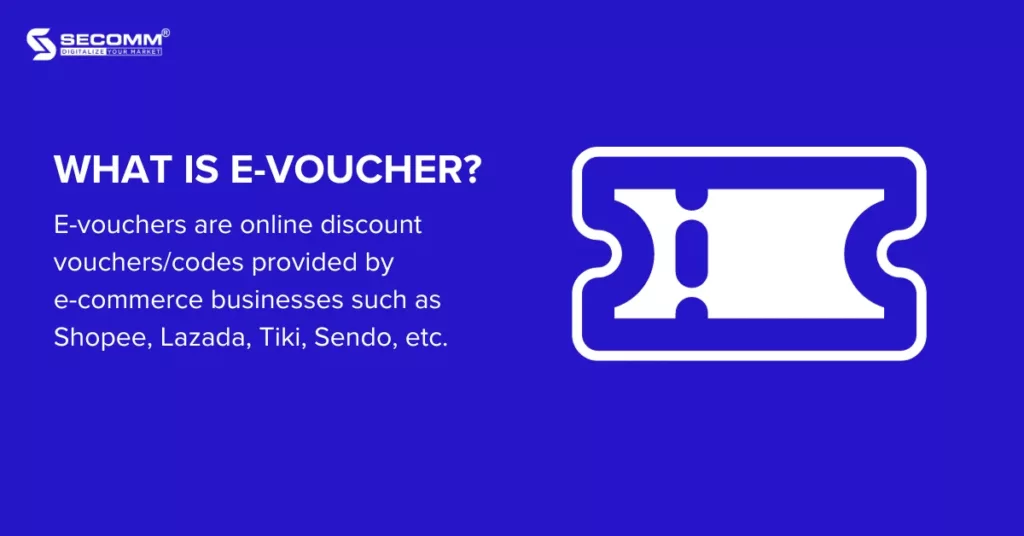
E-vouchers are online discount vouchers/codes provided by e-commerce businesses such as Shopee, Lazada, Tiki, Luxstay, etc. Customers can use them flexibly and conveniently to choose products and services and make payments using e-vouchers.
- Popularity: This payment method has been around for a long time and is favoured by young people for its convenience and savings when shopping.
- Benefits:
- Quick and convenient payments with various discounts.
- Enhance the brand for businesses.
The most popular payment method in ecommerce today is COD. However, due to the “digital transformation” nature of the ecommerce market, electronic payment methods are developing and becoming a new trend in payment services.
In 2020 alone, the revenue from the electronic payment market reached 8,904 million USD, a growth of 14.2% compared to 2019 (according to the Landscape 2020 report). Additionally, developing brand-specific cards/wallets for businesses is a potential method for the ecommerce website payment services.
 2
2

 12,325
12,325

 0
0

 1
1
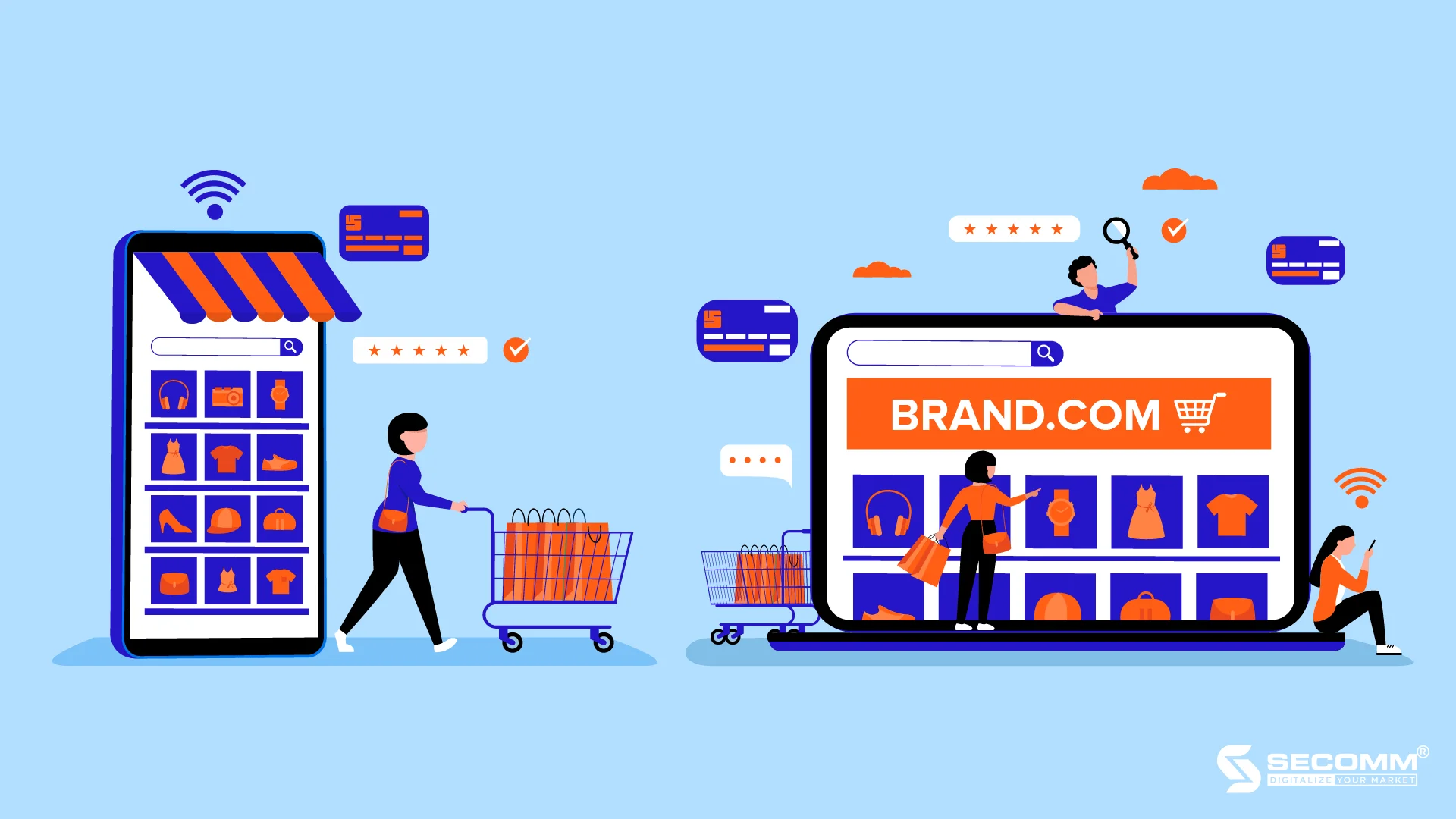
TOP 10 ECOMMERCE TRENDS IN BUILDING ECOMMERCE WEBSITES
Branding plays a crucial role for businesses, especially in the e-commerce market. An effectively built brand in the e-commerce market helps customers recognize and favor the brand, leading to a tendency to shop on e-commerce websites and become loyal customers in the long run. Building a brand on an e-commerce website is the key to sustainable growth for businesses in this market.
Here are 10 prominent trends in building brands on e-commerce websites applied during the current ‘new normal’ era!
Ecommerce Trend: Unique Style
One of the most important tasks for any business during development is to establish a unique style for the brand, especially on e-commerce websites. …Creating an impression in the consumer’s mind helps customers distinguish the brand’s products from competitors. Simultaneously, establishing a unique style creates consistency across all products/services that the e-commerce website provides.
Mobile World Investment Corporation (MWG) has designed a logo and layout with characteristic imagery and uniformity across all e-commerce websites of its brand chain, such as The Gioi Di Dong, Dien May Xanh, Bach Hoa Xanh, Nha Thuoc An Khang. This helps customers of one of the four brands to recall the other brands within MWG.
Ecommerce Trend: Brand Storytelling
Brand storytelling is a method to attract customer attention to a brand through the brand’s origin story and promoting the brand’s mission and vision. Sharing brand stories on e-commerce websites helps businesses create a connection to customers’ awareness.
With the goal of creating a brand image through storytelling, the ‘Coolmate Story’ section on the e-commerce website is built based on its name ‘Coolmate,’ with ‘cool’ symbolizing the cool, dynamic appearance of men and ‘mate’ symbolizing the brand’s mission – to be a companion in men’s fashion. Building a story about a fashion brand for men has made Coolmate’s e-commerce website a popular online shopping destination for young male customers in Vietnam.
Ecommerce Trend: Proudly Vietnamese Brand
The trend of building a “made-in” Vietnam brand is not unfamiliar to customers, from supermarkets with the motto “Vietnamese people use Vietnamese products” to the branding method of “Proudly Vietnamese Brand” appearing on e-commerce websites of Vietnamese brands such as Vinfast, Gumac, Highlands Coffee, etc. … Eliciting pride in the Vietnamese nation and calling for support from customers.
The branding strategies of Biti’s, especially for the Biti’s Hunter product line, are always closely associated with the “made-in-Vietnam” message. When launching the online store https://bitis.com.vn, Bitis also subtly incorporates national elements into every corner of the website, such as images, product information, banners, and blog posts.
Ecommerce Trend: Social Responsibility
Brand positioning associated with community benefits, such as supporting charities, donations, non-profit sales, or becoming a brand that encourages support… Building a brand through charitable activities helps enhance the company’s image in the eyes of consumers, promoting online shopping support on the brand’s e-commerce website.
Vinamilk is always a pioneer in social responsibility activities. Vinamilk has established several community funds to support activities to improve nutritional knowledge, healthcare, and improve clean living environments for surrounding communities, such as the School Milk Program (since 2006), the Vietnam Tall Milk Fund, the 1 Million Green Trees Fund for Vietnam. These messages are consistently conveyed on the company’s website.
Ecommerce Trend: Eco-Friendly
By designing the brand or product lines displayed on e-commerce websites in line with the environmental protection trend, brands can increase public and potential customer sentiment.
Cocoon, a cosmetics brand from Vietnam, has successfully built the “Eco-Friendly” brand image on the current e-commerce market. The “Eco-Friendly” element of Cocoon is immediately shown in the website’s title tag as 100% vegetarian cosmetics. The content on the website consistently emphasizes the brand’s direction of environmentally friendly cosmetics, sourced from natural ingredients, not tested on animals, and certified by international organizations. Thanks to this, Cocoon has successfully positioned the “Eco-Friendly” brand in the hearts of Vietnamese beauty and nature lovers.
Ecommerce Trend: Survival Change
This is a new trend that helps brands maintain their values but adapt their business direction to fit the new normal period, such as:
F&B shifting to cloud kitchens, Travel companies offering touchless and virtual tours…
Changing business models have breathed new life into brands, creating a transformation for the brand. This stimulates curiosity about the brand’s changes among customers.
National Geographic – U.S. National Geographic Society has developed a virtual tour of Vietnam’s Son Doong Cave on its website, combining augmented reality (AR) virtual reality (VR) technology. This achievement not only contributes to the attractiveness of Son Doong Cave but also enhances the brand position for National Geographic, becoming a case study for many famous travel websites about virtual tours.
Ecommerce Trend: Focus on Product Quality
Consumers today are becoming more discerning and will not easily accept low-quality products on the e-commerce market.
Building a brand that focuses on a few high-quality products on the e-commerce website can make customers loyal to the brand and enhance the brand’s reputation.
3 Sach Food, a brand that focuses on providing clean, chemical-free, non-stimulant, and preservative-free products, has successfully attracted a group of customers interested in the quality of food. Thanks to the focus on product quality, 3 Sach Food has successfully attracted the attention of customers interested in food quality.
Ecommerce Trend: Viral Content
Content contributes to developing the relationship between the brand and customers.
Building content with the potential to spread among customer groups will help the brand establish a faster image in the eyes of consumers.
With the goal of building viral content, CellphoneS focuses on updating dramas, hot news, reaction videos, etc., to attract the attention of the youth on the blog website and cleverly embeds technology products, encouraging shopping activities.
Ecommerce Trend: Speak the Customer’s Language
To connect emotionally with customers, businesses need to speak their language.
Responding to customers in the language they use for communication will help them react more quickly to brand marketing campaigns and contribute to leaving a more positive impression after brand-building efforts.
Durex, dubbed the ‘content saint’ in the marketing world, always impresses people with its ability to creatively create content using customer language even on the e-commerce website. Applying customer language not only helps the brand increase sales growth but also becomes a companion in every ‘love affair’ of customers.
Ecommerce Trend: User Experience Enhancement
Brand positioning through digital brand experiences, integrating automation, AI, and virtual reality VR, is considered a new trend for ecommerce businesses. Increasing touchpoints for the brand on e-commerce websites through enhancing the customer experience.
Fitin provides a completely new furniture shopping solution for customers on the e-commerce website and mobile app by integrating 3D technology: VR, AR, Homestyler. Thanks to this, customers not only experience new, professional shopping but also contribute to affirming the position of the Fitin brand in the furniture industry in the eyes of consumers.
Doing ecommerce business in Vietnam is undoubtedly a long-term game for any business entering this market. To develop sustainably, building a brand on e-commerce websites is a prerequisite that cannot be ignored. However, building a brand on eCommerce websites is still a relatively new story for many businesses in Vietnam.
To inquire about free consultation on eCommerce solutions, please contact SECOMM for expert advice.
 2
2

 3,487
3,487

 0
0

 1
1
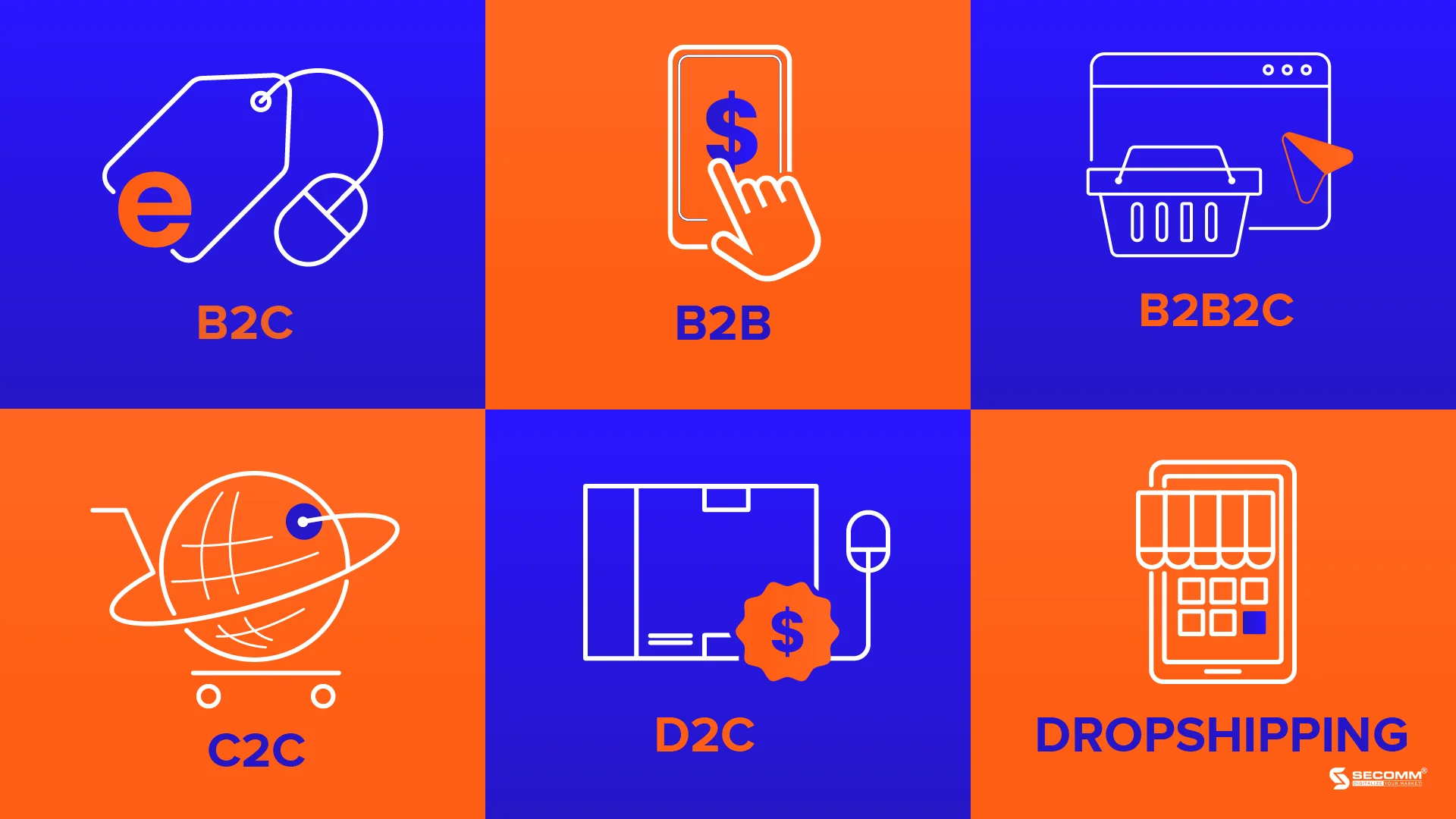
TOP 6 POPULAR ECOMMERCE BUSINESS MODELS IN VIETNAM 2021
Ecommerce Business Model: B2C
B2C (Business To Customer) involves transactions between businesses and customers. This is also the most popular model in the Vietnamese market.
The Gioi Di Dong is the number 1 retail model in Vietnam for electronic devices such as phones, laptops, tablets, and accessories.
- Website: https://www.thegioididong.com/
- Traffic: 49,447,704 (7/2021)
- Website ranking: #18 (Vietnam), #1,075 (Global)
Ecommerce Business Model: B2B
B2B (Business To Business) involves commerce between two businesses.
TELIO is the first B2B e-commerce platform in Vietnam, connecting small-scale traditional retailers with brands and wholesalers on a centralized platform. By aggregating needs, Telio can provide small retailers with more choices, better prices, and more efficient backend support through economies of scale.
- Website: https://www.telio.vn/
- Traffic: 16,109 (7/2021)
- Website ranking: #37,337 (Vietnam), #2,041,569 (Global)
Ecommerce Business Model: B2B2C
B2B2C (Business To Business To Customer) is a collaborative business model between two businesses (B2B) to create and deliver products, services to end consumers (B2C).
Shopee is the most popular e-commerce platform in Vietnam. Shopee Vietnam initially operated as a C2C model, acting as an intermediary in the buying and selling process between individuals. However, Shopee Vietnam has now evolved into a B2B2C model by providing many services and utilities to support the shopping process for both businesses and consumers.
- Website: https://shopee.vn/
- Traffic: 108,842,585 (7/2021)
- Website ranking: #4 (Vietnam), #325 (Global)
Ecommerce Business Model: C2C
C2C (Consumer To Consumer) is a form of business between two individuals, not businesses.
Chotot is a C2C e-commerce website supporting individuals in buying and selling real estate, cars, recruiting, used electronics, pets, and home services.
- Website: https://www.chotot.com/
- Traffic: 36,610,361 (7/2021)
- Website ranking: #50 (Vietnam), #3,369 (Global)
Ecommerce Business Model: D2C
D2C (Direct to Customer) is a form of providing products directly from businesses to customers, bypassing intermediary distribution steps.
Lavender specializes in directly supplying premium bed sheets for homes and hotels in the e-commerce market without relying on any distributors.
- Website: http://lavendervn.com/
- Traffic: 14,036 (7/2021)
- Website ranking: #96,325 (Vietnam), #4,886,255 (Global)
Ecommerce Business Model: DROPSHIPPING
Dropshipping is a business model that allows online stores to operate without storing inventory, owning products, and shipping products to customers.
Selly is an e-commerce platform that supports business sellers without the need for capital, or inventory storage and takes care of shipping to consumers.
- Website: https://www.selly.vn/
- Traffic: 24,936 (7/2021)
- Website ranking: #58,359 (Vietnam), #2,747,670 (Global)
To inquire about free consultation on ecommerce solutions, please contact SECOMM for expert advice.
 2
2

 9,558
9,558

 0
0

 1
1
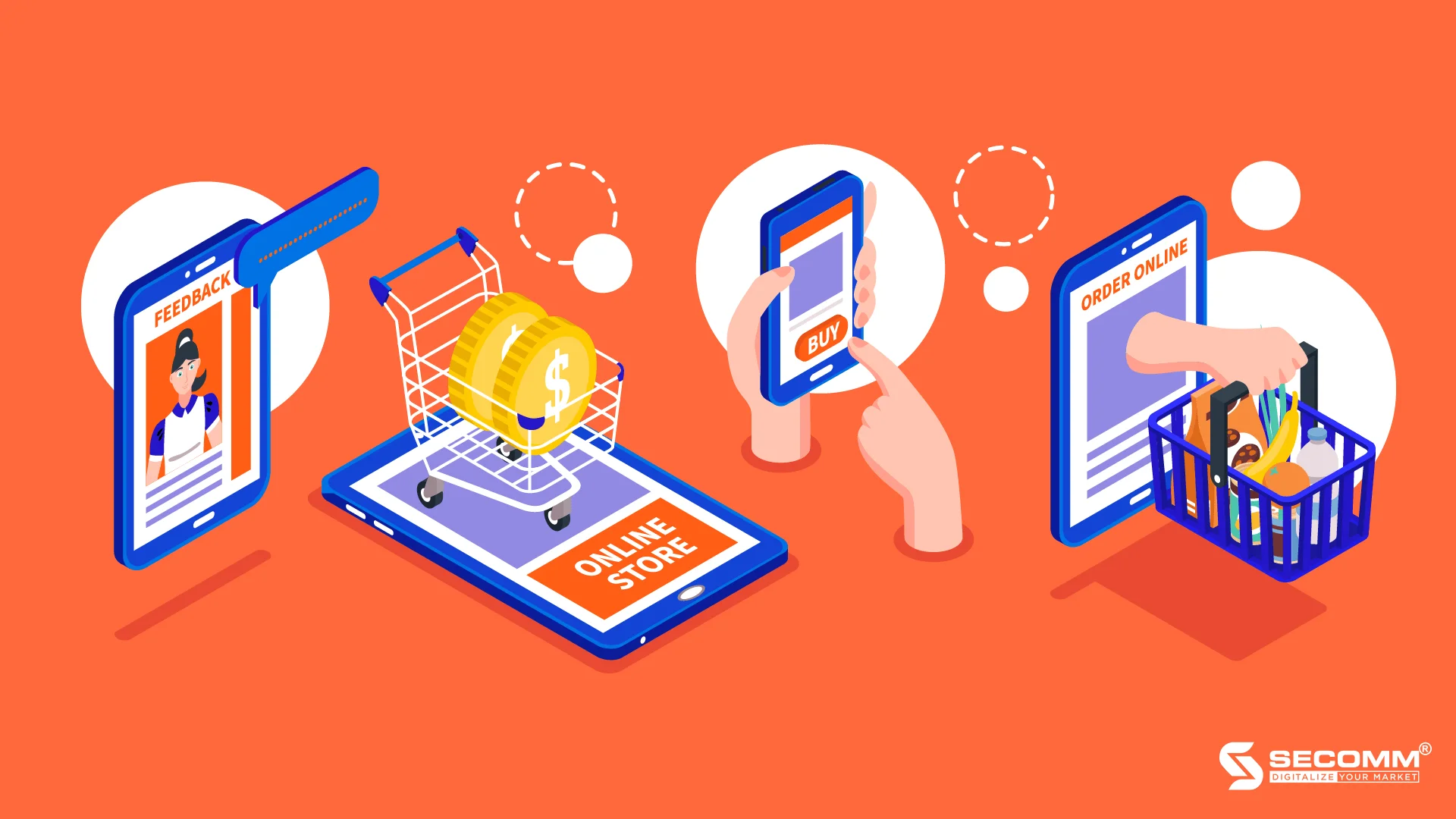
COMPREHENSIVE ECOMMERCE BUSINESS STRATEGY FOR BUSINESSES
To gain a competitive advantage in the Ecommerce market, businesses need a detailed strategy outlining the transition stages and implementation measures for each stage. Determining an Ecommerce business strategy helps provide a comprehensive view of the market, business products, and brand development potential. Below is an Ecommerce business strategy for businesses to reference and guide their operations.
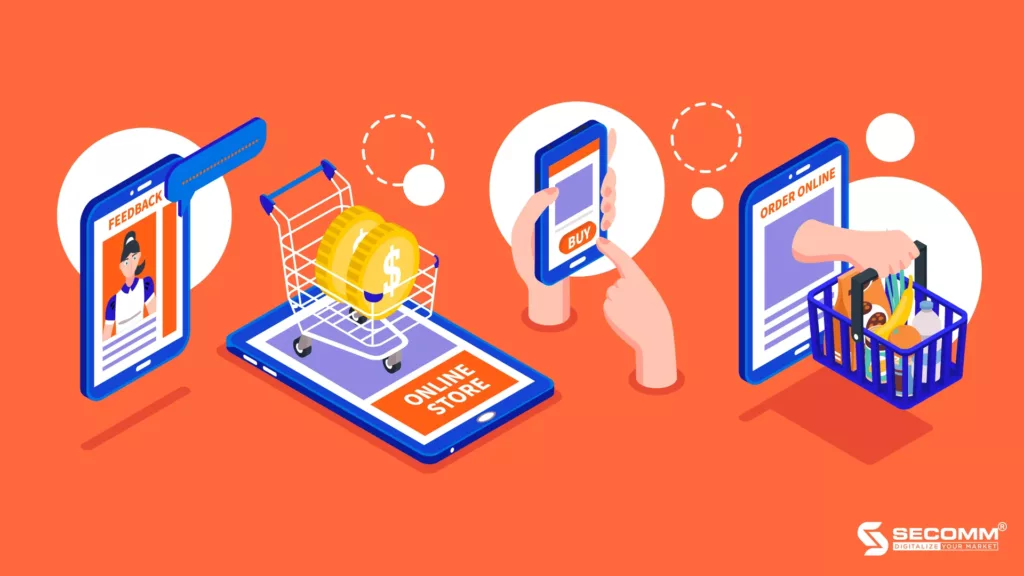
STAGE 1: ONLINE BUSINESS ON SOCIAL MEDIA
Transition the traditional business model to online business on popular social media platforms. This stage allows businesses to test the viability of their products in the online market. Conducting business on social media helps save costs, increases reach, and enhances interaction with customers.
Support Platforms: Facebook, Instagram, TikTok, Zalo.
Business Process on Social Media:
- Establish social channels for the business: Facebook Fanpage, Instagram Shop, TikTok Account, Zalo OA Official.
- Develop brand content and images.
- Implement marketing campaigns: Engagement, Lead Form, Message.
- Collaborate with delivery services to fulfill orders: Grab, Giao Hàng Nhanh, Giao Hàng Tiết Kiệm.
- Maintain social channels: Update information, improve ads, diversify content.
- Use supporting tools to enhance business operations: Order management, Analysis, and Reporting.
STAGE 2: BUILDING ONLINE STORES ON ECOMMERCE MARKETPLACE
Officially join the Ecommerce game by establishing an online store on Ecommerce Marketplace. Utilize existing customer groups on these platforms and leverage support utilities to improve customer services, such as payment services, delivery services, and marketing services.
Support Platforms: Shopee, Lazada, Tiki, Sendo.
Business Process on Ecommerce Marketplaces:
- Set up official stores: Shopee Mall, Lazada Mall, Tiki Official Store, SenMall.
- Update store information: Product names, prices, detailed descriptions, categories, images, videos.
- Configure shipping and payment methods.
- Use available utilities for marketing, fulfillment, sales management, analysis, and reporting.
- Maintain the store: Update information, handle faulty orders, and manage negative feedback.
STAGE 3: BUILDING AN ONLINE SALES WEBSITE
Build a website to position the brand in the online market, utilize search tools to reach a larger potential customer base, and provide business and product information.
Popular Platforms: Wix, Weebly, Spacesquare.
Website Building Process:
- Purchase hosting and domain.
- Choose a platform and register an account.
- Select a suitable interface for the industry, business, and customers.
- Design and edit content: Homepage, Product page, Blog, Recruitment, Contact.
- Integrate supporting tools: Marketing, Analysis, and Reporting.
- Maintain the website: Update information, post blog articles.
STAGE 4: BUILDING AN ECOMMERCE SYSTEM
Designing an Ecommerce website helps businesses expand their online sales channels, connect with more customers, and increase brand coverage in the market. Having a proprietary Ecommerce system allows easier data exploitation and reduces dependency on data from other Ecommerce platforms.
Support Platforms: Sapo, Haravan, Shopify, WordPress, Magento, Bigcommerce, Woocommerce.
Basic E-commerce System Building Process:
- Register an account on the system.
- Design the interface: Choose a template and edit website content.
- Build system functions: Product categories, reviews, product search.
- Provide payment and shipping services.
- Complete legal procedures with the Ministry of Industry and Trade.
STAGE 5: DEVELOPING A DEEP ECOMMERCE SYSTEM
Developing an in-depth Ecommerce system helps maximize Ecommerce revenue, allows easy system upgrades and customization based on specific needs, and introduces new features to enhance the customer experience.
Platforms: Magento, Bigcommerce, Woocommerce.
In-Depth E-commerce System Building Process:
- Define goals for each stage: Brand positioning, revenue increase, user experience enhancement, marketing support.
- Choose a suitable platform for the business model.
- Select a provider based on criteria: E-commerce expertise, professional team, clear processes, available systems, quick support, warranty and maintenance commitments.
- Collaborate in developing the E-commerce system, monitor progress, quality testing.
- E-commerce growth: E-commerce marketing, SEO.
- Maintain and upgrade the E-commerce system.
STAGE 6: OMNI-CHANNEL SALES FOR ECOMMERCE BUSINESS
Implementing Omni-channel helps synchronize all sales channels for easier data management and maximizes Ecommerce business efficiency. Omni-channel creates a seamless experience for customers, allowing businesses to sell through multiple channels and increase conversion rates.
When implementing Omni-channel, businesses can use service providers like ETP Group, NEF, Goell, or choose a centralized system like Magento, ERP.
Omni-channel Implementation Process:
- Collect data: Customer data, Sales data, Marketing data.
- Analyze data to identify areas for effective Omni-channel improvement.
- Design customer journeys, synchronize campaign messages across sales channels.
- Test, measure, and optimize Omni-channel effectiveness.
The journey from Social Commerce to Omni-channel is a common strategy for businesses entering the E-commerce market. However, E-commerce has become increasingly popular in all industries, whether Low-involvement or High-involvement. Many businesses deploy social media channels, Ecommerce platforms, and proprietary E-commerce systems early on to shorten the conversion time, keep up with market trends, and meet the diverse needs of customers.
Depending on the overall business strategy and current situation, each business needs to plan the most suitable development roadmap!
Contact SECOMM for free consulting!
 2
2

 10,790
10,790

 0
0

 1
1
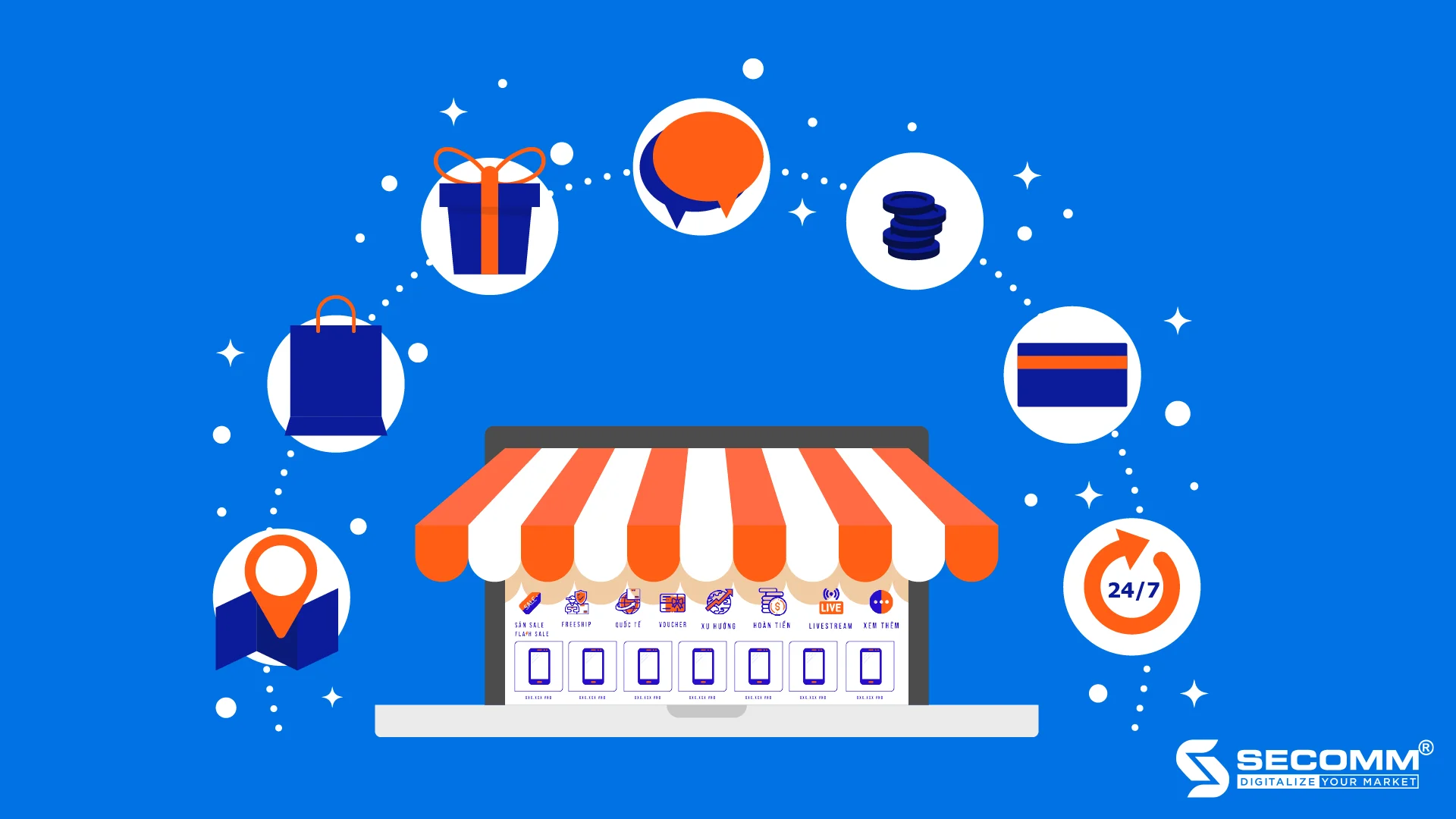
COMPREHENSIVE JOURNEY TO BUILDING ECOMMERCE WEBSITE
As consumer shopping trends shift from offline to online, owning an ecommerce website (EC) is almost a prerequisite for successful business operations. Despite its importance, many businesses are still unsure where to start to build an effective EC website.
Here is a step-by-step journey to building an EC website from basic to advanced for businesses to refer to!
PHASE 1: BUILDING A BASIC ECOMMERCE WEBSITE
When entering the ecommerce market, businesses often build a basic-level ecommerce website to minimize time and budget for website development and gradually adapt to market changes.

Choose a platform to build the website
Businesses can use free website-building tools with ready-made interfaces and features to create a website through simple drag-and-drop operations, without investing too much time and budget in website development and programming. Some popular platforms include Sapo, Haravan, Nhanh.web.
Advantages
- Various ready-made interfaces suitable for different industries and sectors.
- Basic features provided, such as managing product data, prices, images/videos, sales tracking, payment, shipping, marketing, customer management, inventory management, and reporting/analysis.
- Diverse payment methods: COD, card payment, e-wallet.
- Integration with common shipping services: GHN, GHTK, Ninja Van.
Reasonable initial deployment costs with a contract based on usage time.
Disadvantages
- Additional costs may be incurred to use extensions or develop new features for the system.
- Limited customization capability, making it challenging to create a unique brand identity.
- Low flexibility: Difficulty integrating with third-party systems or CRM, ERP, BI…
Design the interface and build functional systems on the chosen platform
Businesses use ready-made templates on the platform and customize them to fit the brand image, industry, and consumer preferences. The chosen platforms offer basic features, and businesses only need to select suitable functions and set them up on the website.
Provide payment and shipping services
- During the ecommerce website development process, businesses need to work with service providers to offer payment and shipping services.
- Common online payment gateways in Vietnam include Paypal, Ngan Luong, VNPay, Airpay, and e-wallets like Momo, ZaloPay.
- Reputable shipping providers in Vietnam include Giao Hang Tiet Kiem, Giao Hang Nhanh, VNPost, ViettelPost.
Complete legal procedures with the Ministry of Industry and Trade
According to Government Decree 52/2013/ND-CP, individuals or organizations that own ecommerce websites for selling goods must notify or register with the Ministry of Industry and Trade on the Ecommerce Management Information Portal.
PHASE 2: TRANSITION TO A SPECIALIZED ECOMMERCE WEBSITE PLATFORM
After using a basic ecommerce website for some time, businesses gradually realize the need to develop an independent, in-depth, and uniquely designed ecommerce website to promote a sustainable ecommerce journey.
Developing a specialized ecommerce website requires both experience and substantial investment in costs and time. However, this is a cost-effective solution for long-term business plans and a suitable transition for a separate and comprehensive ecommerce system.
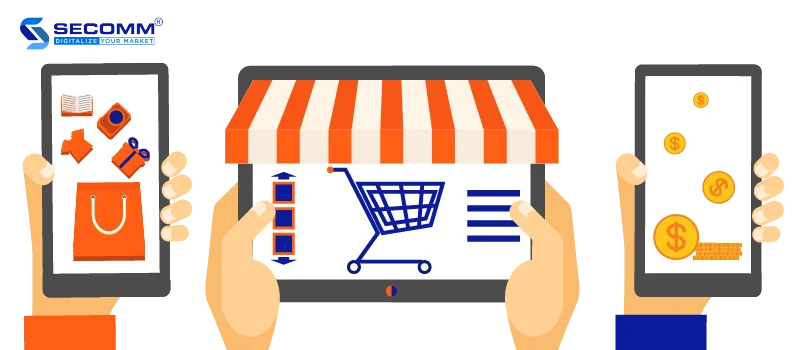
Choose a platform to build the website
At this stage, businesses can choose specialized e-commerce platforms like WooCommerce, BigCommerce, Magento, which are scalable and customizable to maximize the requirements of:
- Open-source e-commerce platforms allow flexible customization according to needs.
- Support customization of the interface to match the brand’s unique style.
- Own a diverse range of functions from basic to advanced.
- Easily integrate with popular shipping and payment providers.
- Manage multiple systems such as CRM, ERP, BI on one screen.
- Easily develop specialized e-commerce functions, especially features related to industry-specific characteristics, brand development, and optimizing customer experience.
- Actively update and quickly develop new features and technologies.
- Flexible and easy integration with in-house systems and third-party systems such as payment, shipping, ecommerce platforms, CRM, ERP, BI…
However, implementing a specialized e-commerce website may face some difficulties:
- High costs and prolonged deployment time.
- Require a skilled and experienced IT team for effective implementation.
Select a website development service provider
When building an ecommerce website on specialized platforms, as it requires time, costs, and high expertise, businesses often collaborate with service providers for ecommerce website development. Afterward, businesses can build an in-house team or continue working with the provider to maintain website operations.
Some service providers for deploying specialized ecommerce systems include SECOMM, SmartOSC, Co-well Asia, Isobar, Magenest.
Develop the ecommerce website
During project deployment based on the agreed solution with the development provider, all factors related to the quality and effectiveness of the website need to be optimized and tested before handover. Especially crucial functions include:
- Category Management: Control data, functions, attributes, prices, inventory, images, and videos of products.
- Content Management: Develop and optimize content for CMS pages, store images, customize themes, and website design.
- Sales Management: Control and operate sales processes, orders, payments, and shipping.
- Marketing Management: Support building and implementing marketing programs using tools like Omni-channel Marketing, Auto Mail.
- Customer Management: Manage and collect customer information for personalized user experiences.
- Inventory Management: Ensure a continuous supply of goods through inventory management tools and shipping direction.
- Reporting & Analysis: Exploit data and measure performance on Google Analytics, Facebook Pixels, Google Tag Manager.
Operate and maintain the ecommerce website
To maintain seamless online-to-offline business operations, the website needs continuous maintenance, care, and updates.
- System Maintenance: Control and monitor all resources on the system to optimize performance.
- Hosting: Web App system, server management, and 24/7 monitoring.
- Cloud: Enhance accessibility and data storage across the entire website system.
Grow the ecommerce website
Implement activities to increase sales operations on the website and stimulate online sales.
- Omni-channel: Set up a sales system, marketing, and data management on the ecommerce website, social networks (Facebook, Instagram, TikTok, Zalo…) and e-commerce platforms (Shopee, Tiki, Lazada…).
- E-commerce Marketing: Analyze and plan comprehensive marketing based on core channels (Content Marketing, Social Marketing, Email Marketing, SEM…).
- SEO: Analyze and optimize website structure, and research specific keywords to build a long-term SEO strategy.
The journey from building a basic to an advanced ecommerce website helps businesses adapt to market changes over time.
 2
2

 3,642
3,642

 0
0

 1
1
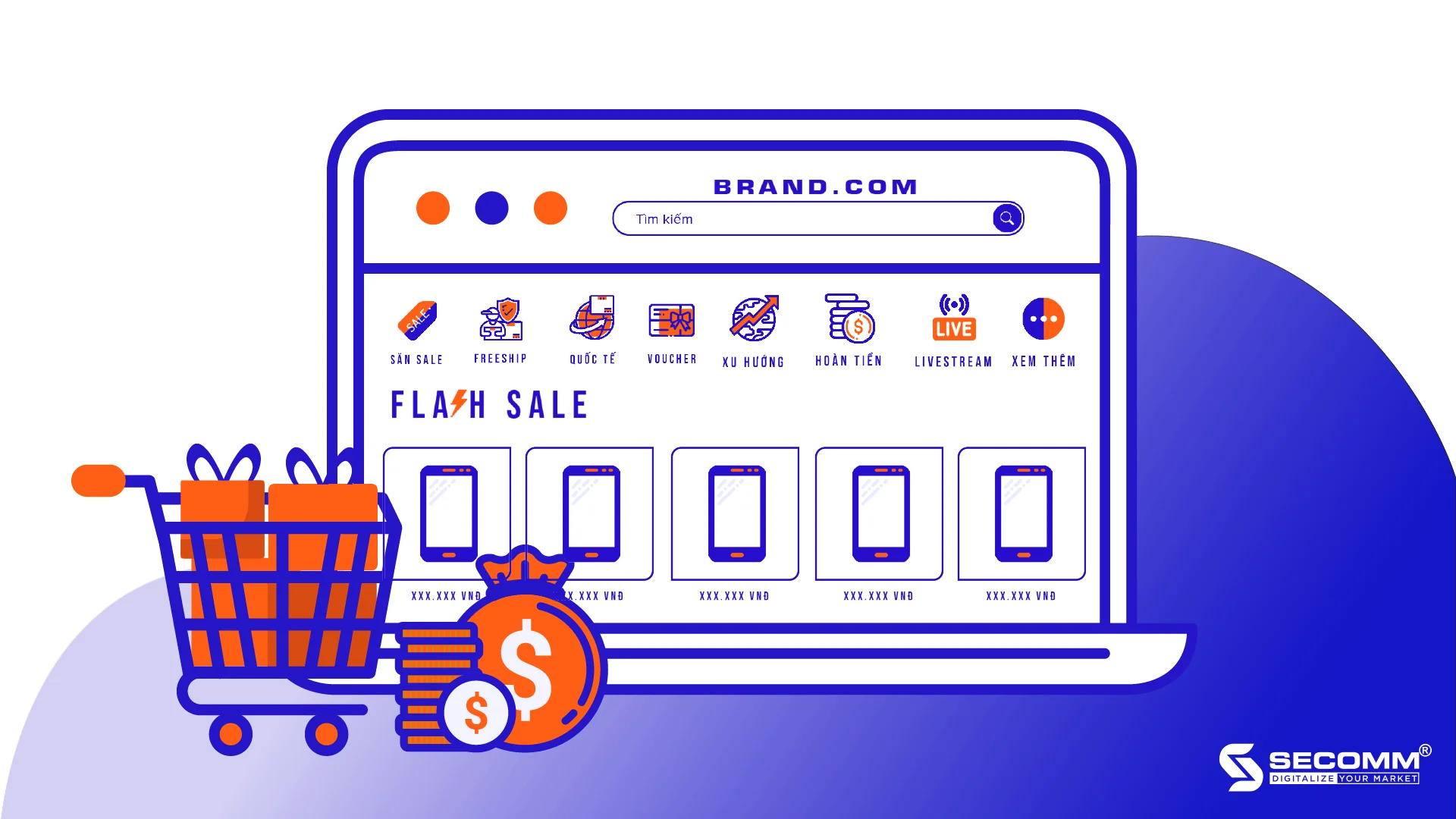
SHOULD YOUR BUSINESS BUILD ITS OWN ECOMMERCE WEBSITE?
Ecommerce website has been a companion for businesses facing COVID-19 challenges in 2020-2021. Efficient utilization of ecommerce (EC) not only helps businesses adapt to changing user and market dynamics but also enables them to seize opportunities and excel in the fiercely competitive landscape. Some successful standalone EC websites include thegioididong.com, bachhoaxanh.com, and fptshop.com.vn.
What is the formula for the success of these businesses?
This success hinges on the ability to have a broad vision and a strategic approach at the management level. Building a dedicated EC website is not just about establishing offline stores; it involves developing and optimizing an EC system that aligns with the business, brand, and users. Building a successful brand website offers various benefits, from brand positioning, cost savings, maximizing revenue to owning all data and controlling the game.
Brand Positioning
A dedicated EC website serves as a medium to convey the brand image and connects businesses with customers in the online market. By owning a dedicated EC website, businesses can easily convey messages, establish specialized marketing campaigns, provide accurate information, and promote the brand to get closer to customers.
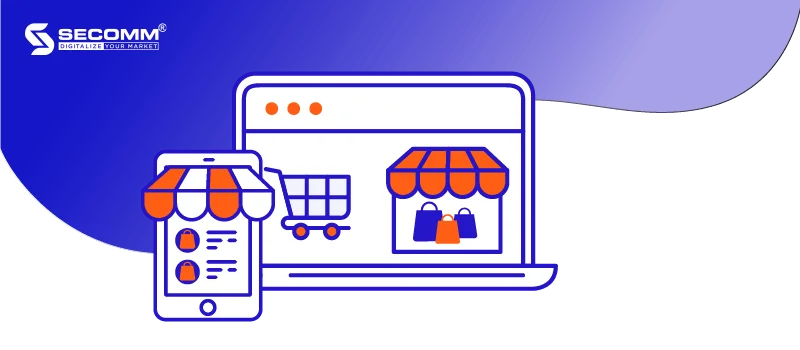
Maximizing Revenue
Operating on a website, businesses are not limited by time and space. Business transactions can occur 24/7, regardless of location. Actively updating and upgrading the system’s features based on user characteristics, business needs, and industry specifics ensures an optimal user experience and facilitates a more convenient and faster purchasing process.
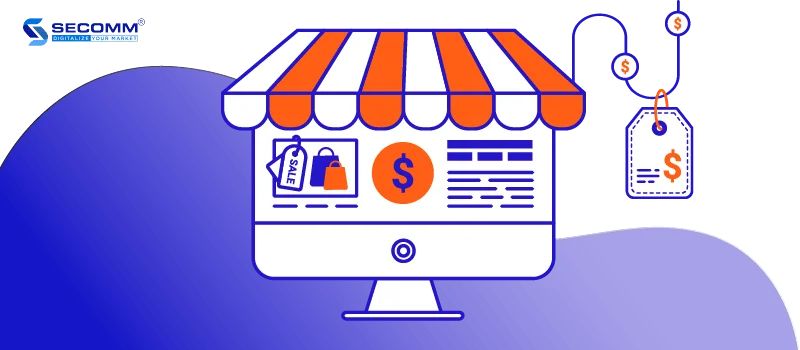
Minimizing Costs
In addition to enabling direct access and sales to customers, eliminating intermediary costs, establishing an online store (brand.com) is an optimal solution for minimizing various expenses such as rent, personnel, and equipment. Moreover, the automated business process with E-Payment, E-Logistic, E-Invoice functions on the website helps save costs related to personnel and paperwork.
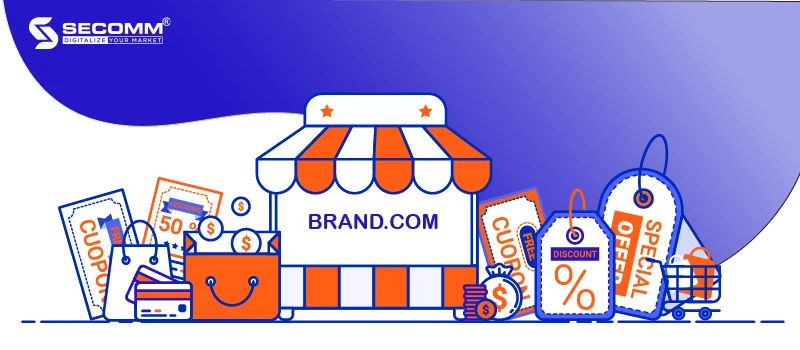
Data Ownership and Control
Building a dedicated EC website means owning a unique “playing field,” reducing dependence on data from EC platforms, social media, or other business systems. With this data, businesses can conduct in-depth data analysis, make business predictions, and develop appropriate directions for the business.
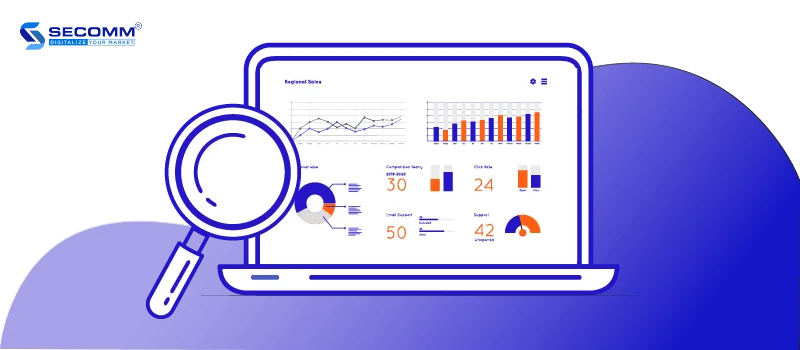
With these superior benefits of deploying a standalone EC website, many businesses have quickly embarked on building an online store for their brand. However, to truly own a successful website that meets specific requirements, similar to Vinamilk, Thế giới di động, Canifa, businesses need a suitable strategy and significant time and investment.
How to build anecommerce website tailored to your business?
With extensive experience in building numerous standalone ecommerce websites for businesses across various sectors, SECOMM fully understands the challenges encountered during the e-commerce deployment process that businesses are facing.
Contact SECOMM to receive consultation on building your own ecommerce website!
 2
2

 2,495
2,495

 0
0

 1
1
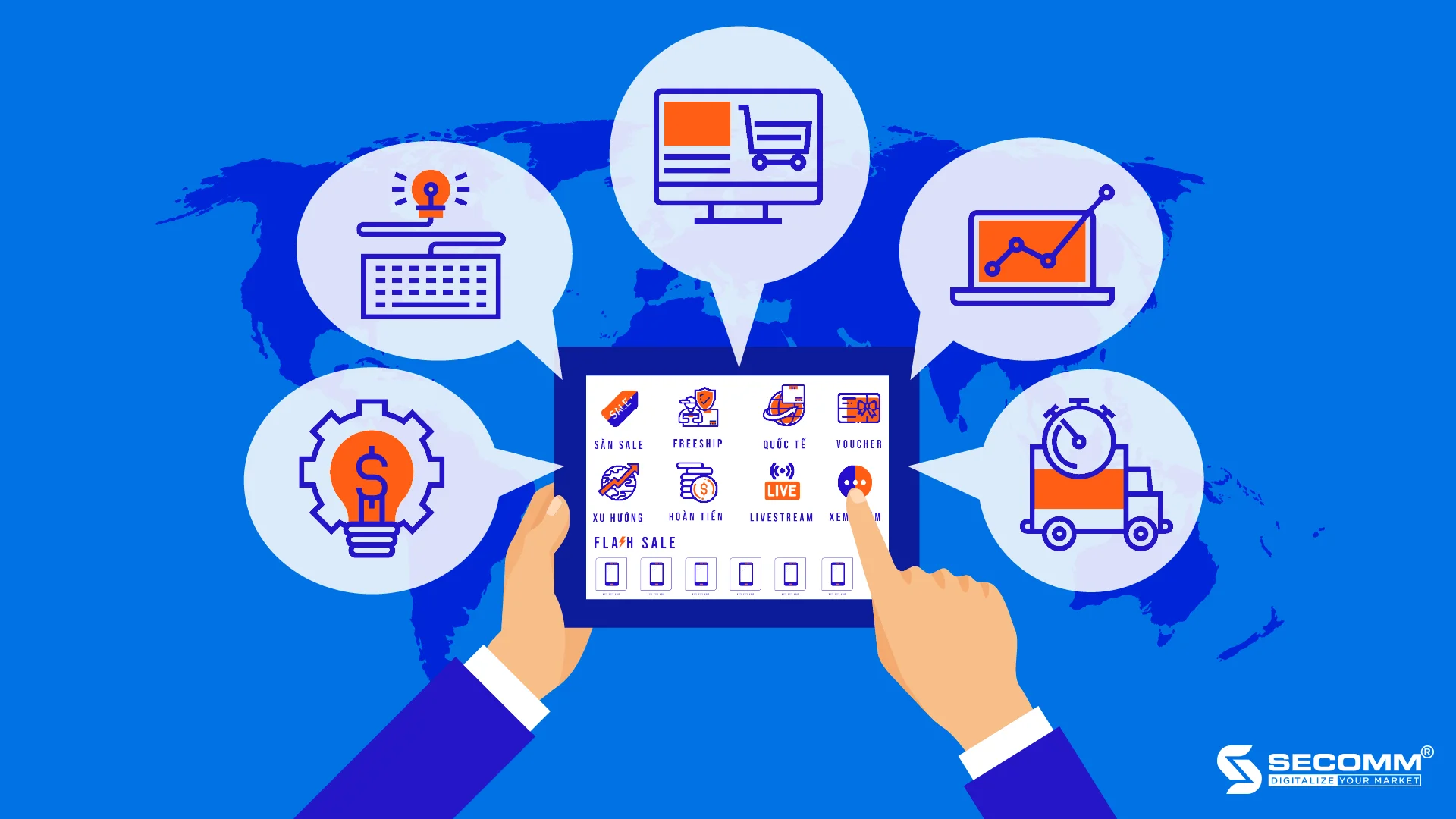
5 STEPS TO EFFECTIVELY IMPLEMENT ECOMMERCE FOR SMES
In the rapidly evolving landscape of today’s economy, where opportunities and competition are just a mouse click away, the effective implementation of E-commerce (EC) is a non-negotiable for businesses, regardless of their involvement in low or high-involvement industries. This comprehensive guide outlines the crucial steps that Small and Medium Enterprises (SMEs) can take to deploy and manage EC strategies successfully, ensuring a competitive edge in the digital marketplace.
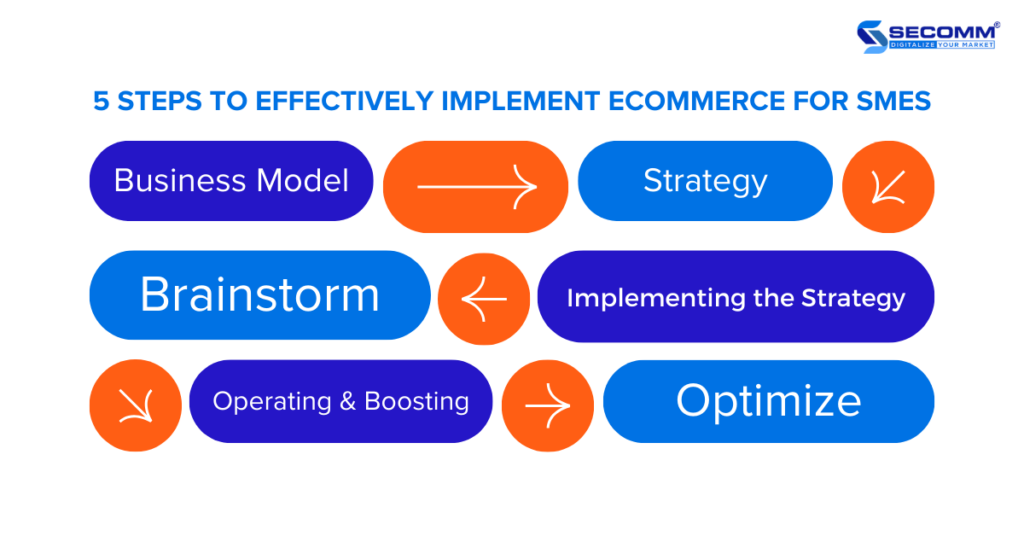
Step 1: Choosing the Right Ecommerce Business Model
The initial phase involves meticulous planning and selecting an EC business model that aligns with the overall development direction of the business. SMEs have three primary models to consider:
- B2B (Business to Business): Focused on transactions between businesses.
- B2C (Business to Customer): Tailored for transactions between businesses and end consumers.
- C2C (Customer to Customer): Involving transactions between individual customers.
Step 2: Developing an Ecommerce Strategy
Building a robust EC strategy is a cornerstone for SMEs. Leveraging the 5W1H method provides a structured approach to strategic planning:
- Who: Identifying potential customers and understanding target demographics.
- What: Defining the chosen business model and selecting technology solutions.
- When: Setting a clear timeline for the campaign, specifying start and end dates.
- Why: Establishing a compelling rationale behind the strategy, supported by relevant data.
- Where: Deciding on selling platforms—whether through social media, EC platforms, or the business’s own website.
- How: Planning the implementation strategy, considering external support from consulting companies or EC solution providers.
Step 3: Implementing the Ecommerce Business Strategy
The focus of this step is on determining purchasing channels and ensuring a seamless customer experience:
- Utilizing popular social media platforms such as Facebook, Instagram, and TikTok to reach a broader audience.
- Establishing stores on well-known EC marketplaces like Shopee, Lazada, Tiki, and Sendo.
- Collaborating with partners to build a professional EC website that reflects the brand’s identity.
- Consolidating content across various channels to provide a consistent and cohesive customer experience.
- Personalizing the user experience through the application of Artificial Intelligence (AI) for product/service recommendations and delivering relevant information.
Step 4: Operating and Boosting Ecommerce Sales
Once the EC system is operational, the emphasis shifts to maintaining and enhancing the system for optimal performance:
- Regularly maintaining, updating, and upgrading the system to adapt to the dynamic changes in the market.
- Implementing E-commerce Marketing strategies to stimulate online sales, including targeted promotions and advertisements.
- Utilizing Search Engine Optimization (SEO) techniques to attract customer attention on popular search engines.
Step 5: Optimizing Post-purchase Services in Ecommerce
Improving post-purchase services is essential for customer satisfaction and increased conversion rates:
- Offering multiple delivery options, including free delivery for a certain quantity, fast delivery, and flexible time options (Morning/Afternoon/Office hours).
- Leveraging E-logistics to enable customers to track and update the order status conveniently through their mobile devices.
In Summary
The implementation of EC is a critical endeavor for SMEs, representing a transformative journey that, when executed effectively, can lead to sustainable growth and increased market share. However, navigating the complexities of the EC landscape requires a strategic approach and a wise investment of time and resources.
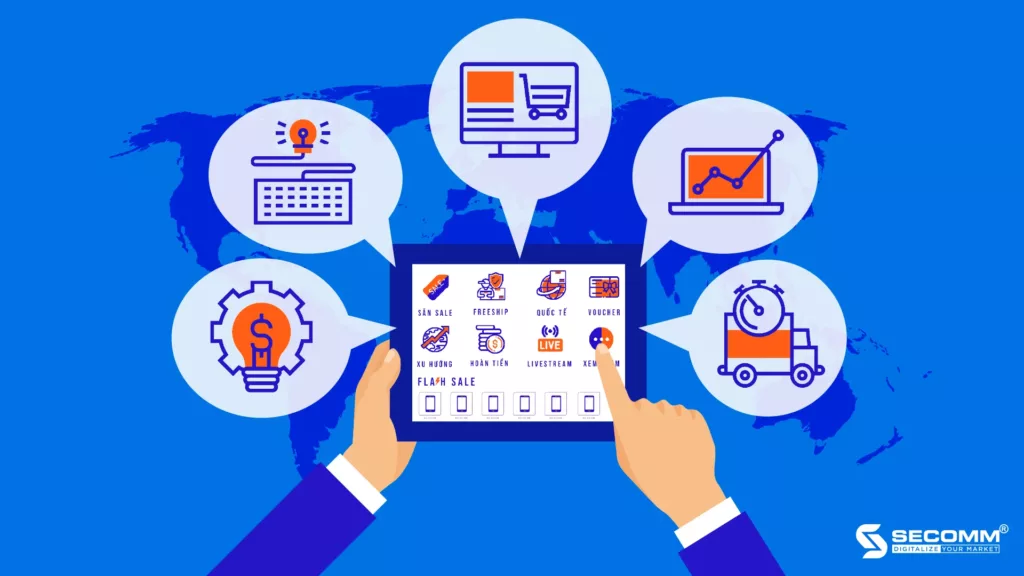
 2
2

 4,346
4,346

 0
0

 1
1





